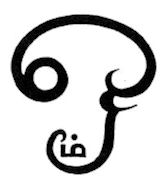

Zitierweise | cite as:
Payer, Alois <1944 - >: Manusmṛti. -- Kapitel 2. -- 3. Vers 36 - 64. -- Fassung vom 2008-10-30. -- http://www.payer.de/manu/manu02036.htm
Erstmals publiziert: 2008-09-27
Überarbeitungen: 2008-10-30 [Verbesserungen]; 2008-10-22 [Verbesserungen]; 2008-10-15 [Verbesserungen]; 2008-10-08 [Verbesserungen]
Anlass: Lehrveranstaltung HS 2008
©opyright: Dieser Text steht der Allgemeinheit zur Verfügung. Eine Verwertung in Publikationen, die über übliche Zitate hinausgeht, bedarf der ausdrücklichen Genehmigung des Verfassers
Dieser Text ist Teil der Abteilung Sanskrit von Tüpfli's Global Village Library
Falls Sie die diakritischen Zeichen nicht dargestellt bekommen, installieren Sie eine Schrift mit Diakritika wie z.B. Tahoma.
Die Verse sind, wenn nichts anderes vermerkt ist, im Versmaß Śloka abgefasst.
Definition des Śloka in einem Śloka:
śloke ṣaṣṭhaṃ guru jñeyaṃ
sarvatra laghu pañcamam |
dvicatuṣpādayor hrasvaṃ
saptamaṃ dīrgham anyayoḥ |
"Im Śloka ist die sechste Silbe eines Pāda schwer, die fünfte in allen Pādas leicht
Die siebte Silbe ist im zweiten und vierten Pāda kurz, lang in den beiden anderen."
Das metrische Schema ist also:
̽ ̽ ̽ ̽ ˘ˉˉ ̽
̽ ̽ ̽ ̽ ˘ˉ˘ ̽
̽ ̽ ̽ ̽ ˘ˉˉ ̽
̽ ̽ ̽ ̽ ˘ˉ˘ ̽
Zur Metrik siehe:
Payer, Alois <1944 - >: Einführung in die Exegese von Sanskrittexten : Skript. -- Kap. 8: Die eigentliche Exegese, Teil II: Zu einzelnen Fragestellungen synchronen Verstehens. -- Anhang B: Zur Metrik von Sanskrittexten. -- URL: http://www.payer.de/exegese/exeg08b.htm
Eine vorzügliche Darstellung des Upanayana um 1920 bei Brahmanen in Rājkot, Kāṭhiāwār, Gujarāt (રાજકોટ, કાઠીયાવાડ, ગુજરાત) findet man in:
Stevenson, Alice Margaret (Mrs. Sinclair Stevenson) <1875-1957>: The sacred thread. -- (Manusmṛti 2, Anhang C). -- URL: http://www.payer.de/manu/manu02a3.htm
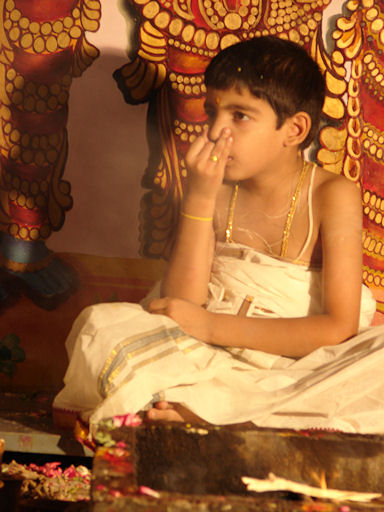
Abb.: Upanayana, Tamil Nadu, 2006
[Bildquelle: calamur. --
http://www.flickr.com/photos/gargi/164758605/. -- Zugriff am 2008-09-10. --
![]()
![]()
![]() Creative
Commons Lizenz (Namensnennung, keine kommerzielle Nutzung, keine Bearbeitung) ]
Creative
Commons Lizenz (Namensnennung, keine kommerzielle Nutzung, keine Bearbeitung) ]
Siehe:
Payer, Alois <1944 - >: Dharmashastra : Einführung und Überblick. -- 10. Sakramente und Übergangsriten (samskara). -- 3. Upanayana = Initiation beim Lehrer (Einschulung). -- URL: http://www.payer.de/dharmashastra/dharmash103.htm
garbhāṣṭame 'bde kurvīta
brāhmaṇasyopanāyanam |
garbhād ekādaśe rājño
garbhāt tu dvādaśe viśaḥ |36|
36. Im achten Jahr nach der Empfängnis soll man das Upanayana1 eines Brahmanen vollziehen, im elften Jahr nach der Empfängnis das für einen Adeligen2, im zwölften Jahr nach der Empfängnis das für einen Vaiśya.
Erläuterungen:
Bühler (S.B.E.):
"36-37. Āp.1, 1,5, 8-21; Gaut. 1,5-14; Vas. II, 3; XI, 49-73 ; Baudh. I, 3, 7-12; Vi. XXVII, 15-28; Yājñ. I, 14."
1 Upanayana = Initiation beim Lehrer (Einschulung)
2 Adeligen:
Medhātithi:
"The term 'king' 'rājan' (in 'rājñaḥ') should be taken as standing for the Kṣattriya caste ; and does not necessarily mean one who is a duly anointed king; firstly because such is the sense in which the word is generally used in books ; secondly because in the present context it occurs along with the terms 'Brāhmaṇa' and the rest (which are all denotative of castes); and thirdly because we find the term 'Kṣattriya' used in the rules that follow regarding the details of the ceremony; e.g., it is said that 'the girdle of the Kṣattriya should consist of the bow-string' (below, Verse 12). It is true that the term 'king' is sometimes used in the sense of the ' rulers' of 'countries,' and as such applied to Vaiśyas and other castes also; but such usage is purely figurative and indirect. And the figurative meaning of a word can be accepted only when the original direct meaning is found inapplicable. That the term 'king' in the text stands for the Kṣattriya. is shown by the following words of the author of the Gṛhya-sūtra— 'One should initiate the Brāhmaṇa in the eighth year, the Kṣattriya in the eleventh and the Vaiśya in the twelfth.' It is on this understanding that the revered Pāṇini derives the word 'rājya' ('Kingship') from the word ' rājan' (King), explaining it as 'the function the King.' and hence used in the ordinary sense of 'lord of country' [i.e., the 'function of ruling a country' really belongs to the Kṣattriya caste, and when persons of other castes are called ' King' their title is based upon their doing 'the work of the King']. " [Übersetzung: Manu-smrti ; the laws of Manu with the bhāsya of Mēdhātithi / translated by Gangā-nātha Jhā [1871 - 1941]. -- [Calcutta] : University of Calcutta, 1920-26. -- Bd. III,1. -- S. 277.]
brahmavarcasakāmasya
kāryaṃ viprasya pañcame |
rājño balārthinaḥ ṣaṣṭhe
vaiśyasyehārthino 'ṣṭame |37|
37. Für einen Brahmanen, der Veda-Glanz1 begehrt ist es im fünften Jahr zu vollziehen, für einen Adeligen, der Macht und Kraft2 begehrt im sechsten, für einen Vaiśya, der Arbeit3 wünscht, im achten.
Erläuterungen:
Bühler (S.B.E.):
"37. As the commentators point out, the person who has the particular wish is not the boy, but his father."
Medhātithi:
""In that case the action done by one person would have its result accruing to a totally different person; and this would involve the absurdity of a man acquiring what he has not earned. And the assertion that the result accrues to the child without his desiring it is one that is contrary to all reason and scriptural authority." There is no force in the objection. The case in question is analogous to that of the Śyena sacrifice : the Śyena is performed by a man seeking to encompass death, and this death falls upon the person against whom the performance is aimed (and not on the performer himself). It might be argued that—"in this case the result actually accrues to the person seeking for it; it is the sacrificer who desires the death of his enemy ; and it is he who obtains this result; so that the result of the act does not accrue to a person that did not perform it."—But in the present case also, the result, in the shape of 'having a child with the particular qualification,' accrues to the performer of the Initiation (the father); just as the good health of the child brings pleasure to the father, so also the Brahmic glory of the son would be a source of pleasure to the father ; so that the result here also would accrue to the performer, who had sought for it. Further, it is only from the construction of the actual words used that we can ascertain the meaning of the scriptural texts; and in the present context, the only construction found possible is that the father should perform the ceremony with the desire of a certain result to accrue to his son; and there are no grounds for abandoning this natural construction of the words.
This same explanation applies also to the case of the benefits of the after-death rites accruing to the father (even though performed by the son); as in that case also the performer is the son, and the result is the satisfaction of the father. Further, we have the text—' Thou art my very self called the son'—which shows that when the after-death rites are performed by the sow, it is the father himself (in the shape of the son) that makes the offerings to himself ; specially as it was with a view to this alone that the father begot the son.
Then again, in the Sarvasvāra sacrifice (which is performed by one who wishes to bring about his own death and translation to heaven),—even after the sacrificer himself has died, the subsequent details have got to be performed: and in this performance also the same sacrificer is regarded as the 'performer,' in view of the direction that he has given to the Brāhmaṇas—' O Brāhmaṇas, please complete this sacrifice,'-— as also of the sacrificial gifts and appointments made by him; by virtue of which the said sacrificer is regarded as the actual instigator or employer of the officiating priests. In the same manner, in the case in question also, in as much as the son was begotten for the purpose of performing the funeral rites, these rites, though performed (by the son) for the sake of the father, are regarded as performed by the father himself.
'Brahrnic glory' is proficiency in Vedic learning.
'Power'—is strength, moral as well as physical; moral strength consisting in courage and energy; and physical strength in the possession of elephants, horses, infantry and full treasury. It is with reference to this that we have the assertion—'the full development of kingly power consists in the excellence of military organisation.'
'Iha,' 'Business,' is action, i.e., agricultural and commercial transactions carried on by means of large capital. "
[Übersetzung: Manu-smrti ; the laws of Manu with the bhāsya of Mēdhātithi / translated by Gangā-nātha Jhā [1871 - 1941]. -- [Calcutta] : University of Calcutta, 1920-26. -- Bd. III,1. -- S. 278f.]
1 Veda-Glanz
Medhātithi:
'Brahrnic glory' is proficiency in Vedic learning. [Übersetzung: Manu-smrti ; the laws of Manu with the bhāsya of Mēdhātithi / translated by Gangā-nātha Jhā [1871 - 1941]. -- [Calcutta] : University of Calcutta, 1920-26. -- Bd. III,1. -- S. 279.]
2 Macht
Medhātithi:
"'Power'—is strength, moral as well as physical; moral strength consisting in courage and energy; and physical strength in the possession of elephants, horses, infantry and full treasury. It is with reference to this that we have the assertion—'the full development of kingly power consists in the excellence of military organisation.'" [Übersetzung: Manu-smrti ; the laws of Manu with the bhāsya of Mēdhātithi / translated by Gangā-nātha Jhā [1871 - 1941]. -- [Calcutta] : University of Calcutta, 1920-26. -- Bd. III,1. -- S. 279.]
3 Arbeit
Medhātithi:
"'Īhā,' 'Business,' is action, i.e., agricultural and commercial transactions carried on by means of large capital. " [Übersetzung: Manu-smrti ; the laws of Manu with the bhāsya of Mēdhātithi / translated by Gangā-nātha Jhā [1871 - 1941]. -- [Calcutta] : University of Calcutta, 1920-26. -- Bd. III,1. -- S. 279.]
ā ṣodaśād brāhmaṇasya
sāvitrī nātivartate |
ā dvāviṃśāt kṣatrabandhor
ā caturviṃśater viśaḥ |38|
38. Bis zum sechzehnten Jahr ist der rechte Zeitpunkt für die Sāvitrī1 für einen Brahmanen nicht überschritten, bis zum zweiundzwanzigsten für einen dem Adel Angehörigen, bis zum vierundzwanzigsten für einen Vaiśya.
Erläuterungen:
Bühler (S.B.E.):
"38-40. Āp. I, I, 22-2, 10; Gaut. XXI, 11; Vas. XI, 74-79; Baudh. 1, 16, 16; Vi., loc. cit., and LIV, 26; Yājñ. I, 37-38. ' Some' take the preposition ā, 'until,' in the sense of ' until the beginning of,' Kullūka"
Medhātithi:
"People explain the particle 'ā' as denoting inclusion. In support of what is said in this verse people cite the Vedic text—'The Brāhmaṇa should be initiated with the Gāyatrī, the Kṣattriya with the Triṣṭubh and the Vaiśya with the Jagatī' [the Gāyatrī metre containing 24, three times eight, the Triṣṭubh 33, three times eleven, and the Jagatī, 48, four times twelve, syllables]; the ages spoken of in the text (16, 22 and 24) suffice to complete two quarters of each of the three metres ; up till then the metres retain their force and do not abandon the castes that form their receptacles ; when however the third quarter has passed, they lose their essence, become aged and having their force reduced, they disappear, just as the man becomes old at 50 (which represents two quarters of his life of 100 years). It is for this reason that the said metres abandon their respective castes, when they find that they have not been studied by them; and it is thus that (after the said ages) the Brāhmaṇa ceases
to be 'related to the Gāyatrō,' the Kṣattriya ceases to be 'related to the Triṣṭubh' and the Vaiśya ceases to be 'related to the Jagatī.'"[Übersetzung: Manu-smrti ; the laws of Manu with the bhāsya of Mēdhātithi / translated by Gangā-nātha Jhā [1871 - 1941]. -- [Calcutta] : University of Calcutta, 1920-26. -- Bd. III,1. -- S. 281f.]
1 Sāvitrī: Vedisches Lied an Gott Savitṛ
"In Vedic religion, Savitṛ (stem), Savitā (nominative singular) is a solar deity (see Deva) and one of the Ādityas. His name is in Vedic Sanskrit meanings "impeller, rouser, vivifier". Savitṛ is described in the Vedas as having golden arms, hands, hair, etc. He is sometimes identified with, and at other times distinguished from, the chief Sun deity Sūrya. A number of beautiful Vedic hymns are invoked in his praise. He is the god of the Sun at Sunrise and Sunset, and was most often invoked in the latter role in Vedic hymns."
[Quelle: http://en.wikipedia.org/wiki/Savitr. -- Zugriff am 2008-09-25]
Medhātithi:
"'Sāvitrī'—is the name of that verse which has Savitṛ for its deity; and that such a verse is the Gāyatrī has been shown above, on the strength of the Gṛhyasūtras. For the Kṣattriya, the 'Sāvitrī' is the verse 'Ākṛṣṇena, etc' (Ṛgveda, 1.35.2; Vājasaneya, 33.13), which is in the Triṣṭubh metre; and for the Vaiśya, it is the verse 'Viśvā rūpaṇi, etc.' Ṛgveda, 5.81.2; Vājasaneya, 12.3)."
[Übersetzung: Manu-smrti ; the laws of Manu with the bhāsya of Mēdhātithi / translated by Gangā-nātha Jhā [1871 - 1941]. -- [Calcutta] : University of Calcutta, 1920-26. -- Bd. III,1. -- S. 282.]
Brahmane: Gāyatrī: Ṛg-Veda 3.62.10:
oṃ bhūr bhuvaḥ svaḥ
tat savitur vareṇiyaṃ
bhargo devasya dhīmahi |
dhiyo yo naḥ pracodayāt"oṃ bhūr bhuvaḥ svaḥ. Dieses vorzügliche Licht des Gottes Savitṛ empfingen wir, der unsere Gedanken anregen soll."
ˉ˘˘ˉ˘ˉ˘ˉ
ˉˉˉˉ˘ˉ˘ˉ
˘ˉˉˉ˘ˉ˘ˉ[Übersetzung: Der Rig-Veda / aus dem Sanskrit ins Deutsche übersetzt und mit einem laufenden Kommentar versehen von Karl Friedrich Geldner [1852 - 1929]. -- Cambridge, Mass. : Harvard Univ. Press, 2003. -- (Harvard Oriental series ; v. 63). -- ISBN 0-674-01226-7] Mit Akzenten:

Wenn Sie den untenstehenden Button mit der Maus anklicken können Sie die Rezitation der Gāyatrī durch Bhagavan Sri Sathya Sai Baba hören [Quelle: http://sss.vn.ua/gayatr_l.htm. -- Zugriff am 2004-02-01]Eine andere Rezitation [Quelle: http://www.geocities.com/BourbonStreet/Delta/5349/suntemplesindia.html. -- Zugriff am 2004-02-07]
Kṣatriya: Triṣṭubh: Ṛgveda 1.35.2
ā kṛṣṇena rajasā vartamāno
niveśayann amṛtam martiyaṃ ca |
hiraṇiyayena savitā rathe-
nā devo yāti bhuvanāni paśyan ||Indem er mit dem schwarzen Dunst sich heranbewegt und Gott und Mensch zur Ruhe bringt, kommt Gott Savitṛ auf goldenem Wagen, die Wesen beschauend. ˉˉˉ˘˘˘ˉˉ˘ˉˉ
˘ˉ˘ˉ˘˘ˉˉ˘ˉˉ
˘ˉ˘˘ˉ˘˘˘ˉ˘ˉ
ˉˉˉˉ˘˘˘ˉ˘ˉˉ[Übersetzung: Der Rig-Veda / aus dem Sanskrit ins Deutsche übersetzt und mit einem laufenden Kommentar versehen von Karl Friedrich Geldner [1852 - 1929]. -- Cambridge, Mass. : Harvard Univ. Press, 2003. -- (Harvard Oriental series ; v. 63). -- ISBN 0-674-01226-7] Mit Akzenten:

Vaiśya: Jagatī: Ṛgveda 5.81.2:
viśvā rūpāṇi prati muñcate kaviḥ
prāsāvīd bhadraṃ dvipade catuṣpade |
vi nākam akhyat savitā vareṇiyo
anu prayāṇam uṣaso vi rājati ||Alle Gestalten legt der Seher an. Zweifüßlern und Vierfüßlern hat er jetzt Gutes zugewiesen. Savitṛ, der Vorzügliche, hat jetzt nach dem Himmelsraum Ausblick gehalten; nach der Ausfahrt der Uṣas führt er das Regiment. ˉˉˉˉˉ˘˘ˉ˘ˉ˘ˉ
ˉˉˉˉˉ˘˘ˉ˘ˉ˘ˉ
˘ˉ˘ˉˉ˘˘ˉ˘ˉ˘ˉ
˘ˉ˘ˉ˘˘˘ˉ˘ˉ˘ˉ[Übersetzung: Der Rig-Veda / aus dem Sanskrit ins Deutsche übersetzt und mit einem laufenden Kommentar versehen von Karl Friedrich Geldner [1852 - 1929]. -- Cambridge, Mass. : Harvard Univ. Press, 2003. -- (Harvard Oriental series ; v. 63). -- ISBN 0-674-01226-7]
ata ūrdhvaṃ trayo 'py ete
yathākālam asaṃskṛtāḥ |
sāvitrīpatitā vrātyā
bhavanty āryavigarhitāḥ |39|
39. Danach werden auch diese drei, wenn sie nicht rechtzeitig den Saṃskāra Übergangsritus) empfangen haben, von der Sāvitrī ausgeschlossene Vrātyas1, von den Āryas Getadelte.
Erläuterungen:
1 Vrātya:
"A few words may first be said about the Vrātyastoma. The Tāṇḍya-Mahābrāhmaṇa (or the Pañca-viṃśa, as it is called from the number of Adhyāyas) describes four vrātyastomas in chap. 17. 1-4 (khaṇḍas). The meaning of many words and passages in that chapter of the brāhmaṇa is uncertain and somewhat cryptic. The four vrātyastomas were ekāhas (i. e. sacrifices taking one day only). Tāṇḍya 17. 1. 1 begins with the story that when the gods went to the heavenly world some dependents of theirs who lived the vrātya life were left behind on the earth. Then through the favour of the gods the dependents got at the hands of Maruts the Ṣoḍaśastoma (containing 16 stotras ) and the metre ( viz, anuṣṭubh) and then the dependents secured heaven. The Ṣoḍaśastoma is employed in each of the four vrātyastomas, the first of which (17. 1 ) is meant for all vrātyas, the 2nd is meant for those who are abhiśasta ( who are wicked or guilty of heavy sins and so censured) and lead a vrātya life, the third for those who are youngest and lead a vrātya life, and the fourth who are very old and yet lead a vrātya life. Some of the passages convey a tolerably clear idea of what the vrātyas were like. Those who lead the vrātya life are base and are reduced to a baser state, since they do not observe student-hood (brahmacarya ) nor do they till the soil nor engage in trade. It is by the Ṣoḍaśastoma that they can attain this (superior status). This shows that the vrātyas did not perform upanayana and did not study the Veda, nor did they do even what vaiśyas do. Another passage says 'those swallow poison who eat food of the common people as food fit for brāhmaṇas, who call good words bad, who strike with a stick him who does not deserve to be beaten (or punished), who, though not initiated, speak the speech of the initiated. The Ṣoḍaśastoma has the power to remove the guilt of these. That (in this rite) there are four Ṣoḍaśastomas, thereby they are freed from guilt. This passage indicates that the Vrātyas spoke the same language as the orthodox people, but were rough in their ways and lax as regards the food they partook of. They were thus outside the pale of orthodox Aryan society and they were brought within it by the Vrātyastoma described in the Tāṇḍya. The origin of the word vrātya is lost in the mists of antiquity. The 15 th Kanda of the Atharvaveda glorifies the vrātya and identifies him with the Creator and Supreme Being. The word is probably derived from vrata (group) and means 'he who belongs to or moves in a group.' It is possible to derive the word from vrata. Originally vrātyas appear to have been groups of people who spoke the same language as orthodox āryas, but did not follow their discipline and habits. The word vrata occurs in Ṛg. I. 163. 8, III. 26. 6, V. 53. 11. Śāyana also perceived the difficulty raised by the glorification of the vrātya in the Atharvaveda 15. 1. 1 and his note is interesting, since he says that description does not apply to all vrātyas, but only to some very powerful, universally respected and holy vrātya who was, however, not in the good books of the brāhmaṇas that were solely devoted to their own rites and sacrifices. Kātyāyanaśrauta XXII. 4. 1-28 and Āp. Śrauta XXII. 5. 4-14 also deal with Vrātyastoma. Kātyāyana describes the four vrātyastomas and adds 'by performing the vrātyastoma sacrifice, they should cease to be vrātyas and become eligible for social intercourse with the orthodox āryas.' The Pār. gṛ. II. 5 quotes the last sutra of Kātyāyana with the remark "for such persons he who desires to have the sacrament (saṃskāra of upanayana) performed on them should perform the sacrifice of vrātyastoma and then may indeed study the Veda for a text says 'they become eligible for (social) intercourse.' " In the Vrātyatā-śuddhisaṃgraha provision is made for the purification of vrātyas even after twelve generations (vide pp. 7 and 22-24) and that work adds ( p. 42) that the Vrātyastoma like the penance for an avakīrṇin is to be performed in the ordinary fire (laukika agni). It also suggests easy substitutes for the lengthy and trying penance of twelve years prescribed by Āp."
[Quelle: Kane, Pandurang Vaman <1880 - 1972>: History of Dharmasastra : (ancient and mediaeval, religious and civil law). -- Poona : Bhandarkar Oriental Research Institute. -- Bd. II, 1. -- 2. ed. -- 1974. -- S. 385 - 387.]
naitair apūtair vidhivad
āpady api hi karhicit |
brāhmān yaunāṃś ca saṃbandhān
nācared brāhmaṇaḥ saha |40|
40. Solange solche sich vorschriftsgemäß nicht gereinigt haben, soll ein Brahmane mit ihnen niemals, nicht einmal in einem Notfall, vedische Verbindungen oder Heiratsverbindungen1 eingehen.
Erläuterungen:
Bühler (S.B.E.):
"40. 'Connexion through the Veda,' i. e. teaching them or studying under them, sacrificing for them, or electing them to be priests, accepting religious gifts from them or giving them. Rāghāvananda omits verse 40."
1 vedische Verbindungen oder Heiratsverbindungen
Medhātithi:
"The question arising as to whether or not this prohibits all kinds of relationship, the text supplies the answer in the negative—' spiritual or uterine? The term 'brāhma,' 'spirit,' here stands for the Veda ; and it is relationships through the Veda that are prohibited ; such relationships as officiating at sacrifices, teaching and accepting gifts ; the meaning being that one should neither officiate at their sacrificial performances, nor appoint them to officiate at sacrifices, they should not be taught, nor should one read with them. Since it is only one who knows the meaning of the Veda that is entitled to accept gifts, the accepting of gifts also becomes a 'Vedic' or ' spiritual' relationship.
'Uterine relationship,'—the giving and taking of daughters in marriage.
The specification of the 'Brāhmaṇa' is intended to be illustrative only.
The sense of all this is that, in view of the disqualification here described, the boy whose father is no more should, if he is intelligent, try to avoid the disqualification, by presenting himself (at the proper time) for Initiation. To this end we have the Śruti—"Satyakāma Jābāla went to Gautama Hāridrumata and said—'I shall, sir, live with you as a religious student"; where the boy himself requested the teacher to initiate him. The initiating of boys is however entirely optional ; so that if the teacher should be found unwilling to take up the initiation, he should be appealed to by the boy by means of presents, etc."
[Übersetzung: Manu-smrti ; the laws of Manu with the bhāsya of Mēdhātithi / translated by Gangā-nātha Jhā [1871 - 1941]. -- [Calcutta] : University of Calcutta, 1920-26. -- Bd. III,1. -- S. 283f.]
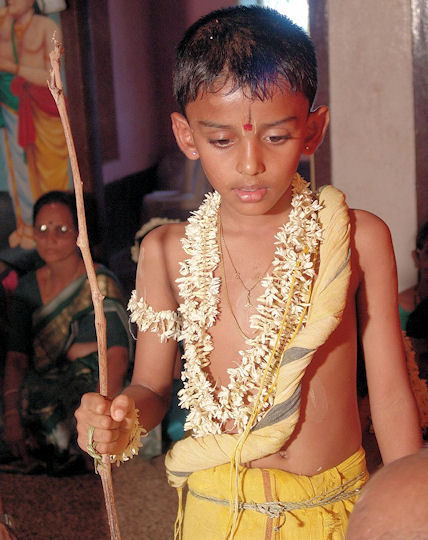
Abb.: "A young boy is seen during upanayana ritual. The yellowed, thin, thread
running from left shoulder to the waist is Yagnopaivta. Also note the girdle of
munja grass around the waist. The twig in the right hand (usually from peepa
treel) siginifies his entry in to Brahmacharya."
[Bildquelle: Nagesh Rao, Wikipedia. GNU FDLicense]
kārṣṇarauravabāstāni
carmāṇi brahmacāriṇaḥ |
vasīrann ānupūrvyeṇa
śāṇakṣaumāvikāni ca |41|
41. In der Reihenfolge der Stände sollen Brahmacārins das Fell einer schwarzen Antilope1, einer Ruru-Antilope2 bzw. eines Ziegenbocks3 tragen, ebenso4 ein Gewand aus Hanf5, Flachs6 bzw. Schafwolle7.
Erläuterungen:
Bühler (S.B.E.):
"41. Āp. I, 2, 39-3, 9; Gaut. I, 16, 21; Vas. XI, 61-67 5 Baudh. I, 3, 14 ; Vi. XXVII, 19-20. Rāghāvananda explains ruru, 'a spotted deer,' by 'a tiger.'"
1 schwarzen Antilope: Hirschziegenantilope : Antilope cervicapra L. Kam ursprünglich auf dem ganzen indischen Subkontinent vor von Punjab und Sind bis Bengalen und von Nepal bis Kanyakumari (Cape Comorin) (Tamil: கன்னியாகுமரி) Siehe:
Walker's mammals of the world / Ronald M. Nowak. -- 6. ed. -- Baltimore [u.a.] : Johns Hopkins Univ. Pr., 1999. -- 2 Bde. -- ISBN 0-8018-5789-9. -- Bd. 2. -- S. 1193f.

Abb.:
Hirschziegenantilope -- Antilope
cervicapra L., Bock
[Bildquelle:
Wikipedia, public domain]
Siehe oben zu Manu 2,23.
2 Ruru-Antilope = Boselaphus tragocamelus = Nilgauantilope
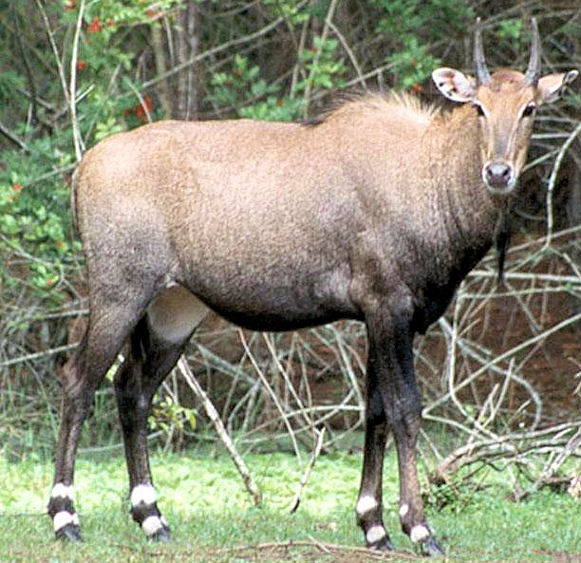
Abb.: Ruru-Antilope = Boselaphus tragocamelus = Nilgauantilope, Bock
[Bildquelle: Wikipedia; GNU FDLicense]
"Die Nilgauantilope (Boselaphus tragocamelus), meistens nur kurz als Nilgau bezeichnet, ist eine asiatische Antilope. Merkmale
Mit einer Schulterhöhe von 140 cm und einem Gewicht von 300 kg ist dies eine sehr große Antilope. Männchen sind im Schnitt ein Fünftel größer als Weibchen. Nur die Männchen tragen Hörner; diese sind kurz und spießartig und messen etwa 20 cm. Das Fell ist oberseits grau und unterseits weißlich gefärbt. Nur ein Büschel verlängerter Haare an der Kehle sowie die Schwanzspitze sind schwarz. Die Männchen haben einen bläulichen Schimmer im Fell.
VerbreitungHeute ist die Nilgau auf Indien und das südöstliche Pakistan beschränkt. In Bangladesch wurde sie ausgerottet, in Nepal soll sie Gerüchten zufolge noch vereinzelt vorkommen. Nur durch Knochenfunde weiß man, dass diese Antilope bis in historische Zeit noch in Westasien und Ägypten vorkam; dort starb sie gegen 500 v. Chr. aus unbekannter Ursache aus.
Das bevorzugte Habitat sind Wälder.
LebensweiseDie tag- und dämmerungsaktive Nilgau hat ein den afrikanischen Verwandten vergleichbares Sozialleben: Ältere Männchen sind Einzelgänger; dagegen bilden Weibchen und Jungtiere Herden von etwa zehn Tieren. Jüngere Männchen bilden eigene Verbände oder schließen sich den Weibchenverbänden an. Zur Paarungszeit suchen die Männchen die Gruppen der Weibchen auf und vertreiben gegebenenfalls dort anwesende andere Männchen. Oft kommt es dabei zu ritualisierten Kämpfen, bei denen die Hälse gegeneinander gestemmt werden. Ernsthafte Kämpfe mit den Hörnern sind sehr selten. Ein Männchen versucht, drei Weibchen um sich zu versammeln und sich mit ihnen zu paaren. Aus dieser Verbindung gehen je Weibchen ein bis drei Junge hervor.
Menschen und NilgauantilopenIm Hinduismus wurde die Nilgau wegen ihrer Ähnlichkeit mit Hausrindern als naher Verwandter der „Heiligen Kuh“ eingestuft und war deshalb lange keinerlei Verfolgung ausgesetzt. Seit 1900 sind die Bestände aber vor allem durch Habitatzerstörung zurückgegangen. Die Populationszahlen in Indien werden von der IUCN auf 100.000 geschätzt, in Pakistan sind sie deutlich geringer. In den 1930ern wurden Nilgauantilopen im südlichen Texas ausgesetzt und haben sich dort inzwischen so stark verbreitet, dass ihre Bestandszahlen mit 37.000 beziffert werden. Die Art gilt als ungefährdet."
[Quelle: http://de.wikipedia.org/wiki/Nilgauantilope. -- Zugriff am 2008-09-25]
3 Ziegenbock
Siehe:
Entwicklungsländerstudien / hrsg. von Margarete Payer. -- Teil I: Grundgegebenheiten. -- Kapitel 8: Tierische Produktion. -- 2. Ziegen und Schafe. -- 1. Ziegen / zusammengestellt von Alois Payer. -- URL: http://www.payer.de/entwicklung/entw0821.htm
Bilder indischer Ziegenrassen:
Entwicklungsländerstudien / hrsg. von Margarete Payer. -- Teil I: Grundgegebenheiten. -- Kapitel 8: Tierische Produktion. -- 2. Ziegen und Schafe / zusammengestellt von Alois Payer. -- Anhang A: Bilderbogen einiger Ziegenrassen. -- URL: http://www.payer.de/entwicklung/entw082a.htm
4 ebenso (ca)
Medhātithi:
"The particle 'ca' ('and also') has the cumulative force. The cloth made of hemp and the rest are not to be used as upper garments ; and the skins are to be used as upper garments ; as such is the proper course. For Kaupīna (loin-slip) and wrapping, the cloth is to be used."
[Übersetzung: Manu-smrti ; the laws of Manu with the bhāsya of Mēdhātithi / translated by Gangā-nātha Jhā [1871 - 1941]. -- [Calcutta] : University of Calcutta, 1920-26. -- Bd. III,1. -- S. 284.]
5 Hanf: Cannabis sativa L.

Abb.: Hanffasern
[Bildquelle: Wikipedia; GNU FDLicense]
6 Flachs: Linum usitatissimum L. = Gemeiner Lein

Abb.: Flachsfasern
[Bildquelle: Wikipedia; Public domain]
7 Schafwolle
Siehe:
Entwicklungsländerstudien / hrsg. von Margarete Payer. -- Teil I: Grundgegebenheiten. -- Kapitel 8: Tierische Produktion. -- 2. Ziegen und Schafe. -- 2. Schafe / zusammengestellt von Alois Payer. -- URL: http://www.payer.de/entwicklung/entw0822.htm
Bilder indischer Schafrassen:
Entwicklungsländerstudien / hrsg. von Margarete Payer. -- Teil I: Grundgegebenheiten. -- Kapitel 8: Tierische Produktion. -- 2. Ziegen und Schafe / zusammengestellt von Alois Payer. -- Anhang B: Bilderbogen einiger Schafrassen. -- URL: http://www.payer.de/entwicklung/entw082b.htm
mauñjī trivṛt samā ślakṣṇā
kāryā viprasya mekhalā |
kṣatriyasya tu maurvī jyā
vaiśyasya śaṇatāntavī |42|
42. Der Gürtel für einen Brahmanen soll aus Muñja-Schilfgras1 hergestellt werden, dreifach, gleichmäßig und weich; der für einen Kṣatriya aber sei eine Bogensehne2 aus Mūrvā-Bogenhanf3, der eine Vaiśya aus einem Hanfgewebe4.
Erläuterungen:
Bühler (S.B.E.):
"42. Āp. I, 2, 33-37; Gaut. 1,15; Vas.XI, 58-60; Baudh. I, 3, 13; Vi. XXVII, 18 ; Yājñ. I, 29. Medhātithi and Govindarāja think that the girdle of a Kṣatriya is not to consist of three separate strings twisted together, and Kullūka apparently holds the same opinion. Rāghāvananda and Nārāyaṇa say that every bowstring naturally consists of three strings."
1 Muñja-Schilfgras: Muñja-Gras (Schilfgras, besonders Saccharum munja = Saccharum bengalense Retz. = Erianthus munja = Saccharum ciliare Andersson); Mauñjīnibandhana darum = Upanayana
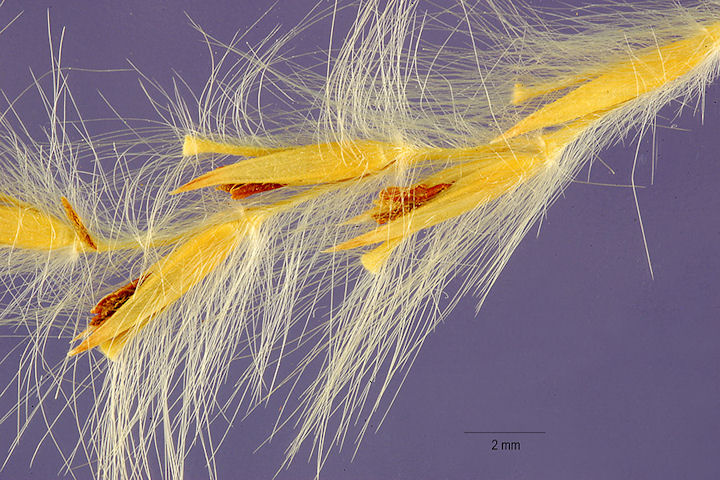
Abb.: Munjagras -- Saccharum bengalense Retz.
[Bildquelle: Tracey Slotta @ USDA-NRCS PLANTS Database. -- Public domain]
2 Bogensehne
Medhātithi:
"'For the Ksattriya the bow-string';—the string of the bow. The bow-string is made sometimes of leathern thong, sometimes of grass or of fibres of hemp or flax ; hence the text specifies it as that 'made of mūrvā grass' ; this string should be taken down from the bow and made into the waist-band. Even though the qualifications of triplicity and the rest apply literally to all kinds of 'girdle,' and not only to that of muñja grass, yet they cannot be applied to the 'bow-string,' as with such qualifications it would entirely lose its character of 'bow-string.'"
[Übersetzung: Manu-smrti ; the laws of Manu with the bhāsya of Mēdhātithi / translated by Gangā-nātha Jhā [1871 - 1941]. -- [Calcutta] : University of Calcutta, 1920-26. -- Bd. III,1. -- S. 286.]
3 Mūrvā-Bogenhanf: Sansevieria roxburghiana Schult. & Schult. f. = Indian bowstring hemp = Indischer Bogenhanf
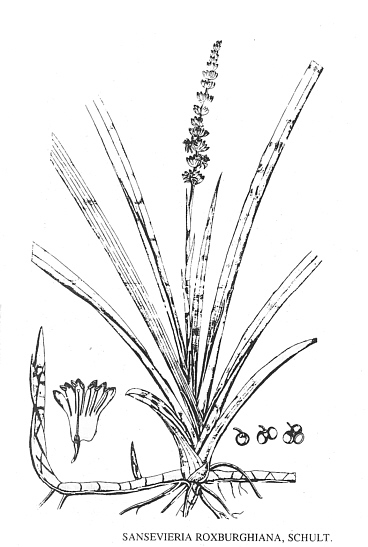
Abb.: Sansevieria roxburghiana
Schult. & Schult. f. = Indian bowstring hemp = Indischer BogenhanfSansevieria
roxburghiana Schult. & Schult. f. = Indian bowstring hemp = Indischer
Bogenhanf
[Bildquelle: Kirtikar-Basu, ©1918]
4 Hanf: Cannabis sativa L.
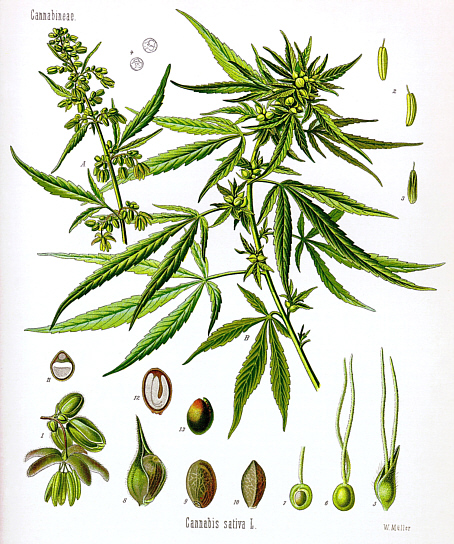
Abb.: Hanf -- Cannabis sativa L.
[Bildquelle: Köhler, ©1887]
muñjālābhe tu kartavyāḥ
kuśāśmantakabalvajaiḥ |
trivṛtā granthinaikena
tribhiḥ pañcabhir eva vā |43|
43. Wenn Muñjagras [usw.] nicht erhältlich ist, dann stelle man die Gürtel aus Kuśa-Gras1, Aśmantaka2 bzw. Balbaja3 her, dreifach mit einem, drei oder fünf Knoten.
Erläuterungen:
Bühler (S.B.E.):
"43. 'With a single threefold knot' seems to mean that each of the strings of the girdle shall first be knotted, and the three knots be afterwards tied together in one. Nārāyaṇa and Rāghāvananda, however, take trivṛtā, ' threefold,' separately, and refer it to the string. They thus support Sir W. Jones' translation, 'in triple strings, with one, &c.'"
1 Kuśa-Gras: Desmostachya bipinnata (L.) Stapf = Briza bipinnata L. = Desmostachya cynosuroides (Retz.) Stapf ex Massey = Coelachyrum longiglume Napper = Cynosurus durus Forssk. = Eragrostis bipinnata (L.) Stapf = Eragrostis cynosuroides (Retz.) Beauv. = Leptochloa bipinnata (L.) Hochst. = Poa cynosuroides Retz.
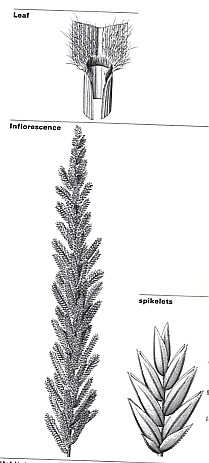
Abb.: Kuśa-Gras = Desmostachya bipinnata (L.) Stapf
[Bildquelle: Häfliger, Ernst ; Scholz, Hildemar: Grass
weeds. -- Basel : Ciba-Geigy, 1980-1982. -- 3
Bde. : Ill. -- (Documenta / Ciba-Geigy). -- Bd. 2. -- S. 59 ]
2 Aśmantaka: = ???
3 Balbaja: Eleusine indica (L.) Gaertn. = Cynosurus indicus L. = Indian goosegrass = Wilder Korakan, Wilde Fingerhirse
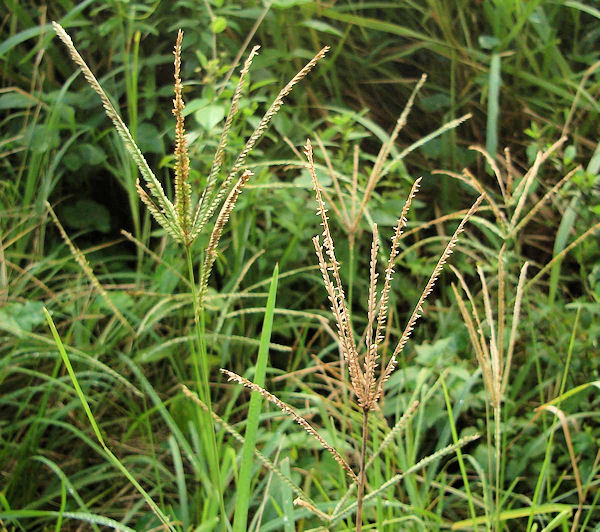
Abb.: Balbaja = Eleusine indica (L.)
Gaertn. = Cynosurus indicus L. =
Indian goosegrass = Wilder Korakan, Wilde Fingerhirse
[Bildquelle: Wikipedia. GNU FDLicense]
kārpāsam upavītaṃ syād
viprasyordhvavṛtaṃ trivṛt |
śaṇasūtramayaṃ rājño
vaiśyasyāvikasautrikam |44|
44. Das Upavīta1 eines Brahmanen sei aus Baumwolle2, nach oben verzwirnt und dreifach3, die eines Adligen bestehe aus Hanffaden4, die eines Vaiśya aus Schafwollfaden5.
Erläuterungen:
Bühler (S.B.E.):
"44. Āp. II, 4, 22 ; Gaut. I, 36; Vas. XII, 14; Baudh. I, 5, 5; Vi. XXVII, 19."
1 Upavīta = yajñopavīta = "heilige Schnur der Zweimalgeborenen"
In den verschiedenen Regionen Indiens werden Upanayana und Yajñopavīta unterschiedlich benannt:
Both the sacred thread and the Upanayanam ceremony are known by different names in different languages.
| # | Language | Name of the ceremony | Word for "Sacred Thread" |
|---|---|---|---|
| 1 | Sanskrit | Upanayanam | Yajñopavītam |
| 2 | Malayalam മലയാളം |
Upanayanam | Poonool (IAST: Pūnūl) |
| 3 | Tamil தமிழ் |
Poonal | Poonal (IAST: Pūnūl) |
| 4 | Telugu తెలుగు |
Odugu |
Jandhyamu |
| 5 | Kannada ಕನ್ನಡ |
Munji | Janivaara |
| 6 | Hindi हिंदी |
Janeu | Janeu |
| 7 | Marathi मराठी |
Munja | Jaanva |
| 8 | Konkani कोंकणी |
Munji | Jannuvey |
| 9 | Bengali বাংলা |
Poita | Poita |
| 10 | Oriya ଓଡ଼ିଆ |
Brata Ghara | Poita |
| 11 | Nepali नेपाली |
Bratabandha | Janai |
| 12 | Kashmiri کٲشُر |
Mekhal | Yonya |
| 13 | Assamese অসমীয়া |
Lagundeoni | Lagun |
| 14 | Tulu ತುಳು |
Upanayana | Janivaara |
| 15 | Gujarati ગુજરાતી |
Yagnopavit | Janoi |
| 16 | Himachal Pradesh | Janeyu | Janeyu |
[Quelle der Tabelle: http://en.wikipedia.org/wiki/Upanayana. -- Zugriff am 2008-09-27]
2 Baumwolle: Gossypium arboreum L. = Baumförmige Baumwolle = Tree Cotton
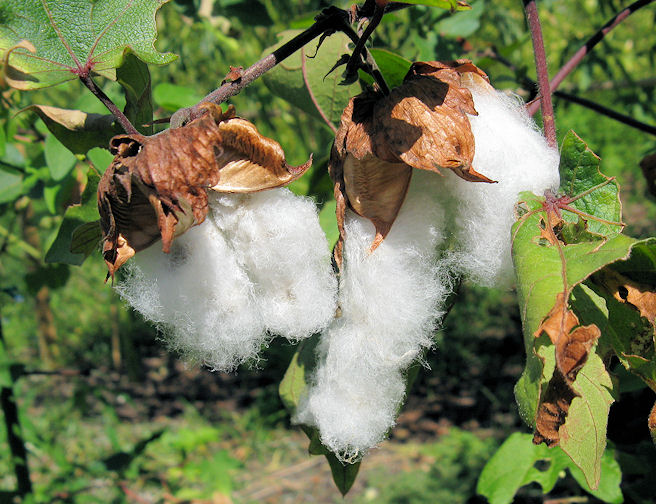
Abb.: Gossypium arboreum L. = Baumförmige
Baumwolle = Tree Cotton
[Bildquelle: KENPEI, Wikipedia. GNU FDLicense]
"Gossypium arboreum, commonly called tree cotton, is a species of cotton native to India and Pakistan and other tropical and subtropical regions of the Old World. There is evidence of its cultivation as long ago as 2000 BC by the Harappan civilization of the Indus Valley for the production of cotton textiles. This species of cotton was introduced into East Africa by about 2000 years ago, and was grown by the Meroe civilization in Nubia, the first cotton weavers in Africa.[citation needed] The shrub was included in Linnaeus's Species Plantarum published in 1753. The holotype was also supplied by him, which is now in the Linnean Herbarium in the Swedish Museum of Natural History.[1] Description
Tree cotton is a shrub attaining heights of 1 to 2 metres. Its branches are covered with pubescence and are purple in colour. Stipules are present at the leaf base and they are linear to lanceolate in shape and sometimes falcate (i.e. sickle-shaped). The leaves are attached to the stem by a 1.5 to 10 cm petiole. The blades are ovate to orbicular in shape and have 5 to 7 lobes, making them superficially resemble a maple leaf. The lobes are linear to lanceolate, and often a tooth is present in the sinus. Glands are present along the midrib or occasionally on the adjacent nerves. The leaves are glabrescent, meaning the pubescence is lost with age, but when it is present on young leaves, it is both stellate (i.e. star-shaped) and simple.[1]
The flowers are set on short pedicels (i.e. flower stalks). An epicalyx is present, which is a series of subtending bracts that resemble sepals. It has large, ovate segments that are dentate (i.e. toothed along the margins), though sometimes only very slightly so. They are cordate (i.e. heart-shaped) at the base and acute at the apex. The true calyx is small, measuring only about 5 mm in length. Its shape is cupular, and there are 5 subtle dentations present. The corolla is a pale yellow on colour, sometimes with a purple centre, and occasionally entirely purple. It measures 3 to 4 cm in length. The staminal tube bears the anthers and is 1.5 to 2 cm in length. The fruit is a 3 to 4 celled capsule measuring 1.5 to 2.5 cm across. It is ovoid or oblong in shape and glabrous (i.e. hairless). The surface is pitted and a beak is present at the termnial end. The seeds within are globular and are covered in long white cotton.[1]
References
- ^ a b c Abedin, Sultanul (1979), "Gossypium arboreum", in Ali, S.I.; Qaiser, M., Flora of Pakistan, 130, St. Louis: University of Karachi & Missouri Botanical Garden, pp. 30"
[Quelle: http://en.wikipedia.org/wiki/Gossypium_arboreum. -- Zugriff am 2008-09-26]
3 nach oben verzwirnt und dreifach
Medhātithi:
"This 'twisting upwards' is laid down for that article which, on coming out of the spinning wheel, has acquired the properties of the 'yarn' and has then been folded three times. That is to say, three yarns should be brought together and by upward twisting made into a cord, and then used as the 'sacred thread.' Of this cord, either only one or three or five or seven should be worn. It comes to be known as the 'sacrificial thread' by reason of its being connected with sacrificial performances; in as much as it is worn for the purposes of sacrificial performances, it is so called figuratively. Now, of the three kinds of sacrifice, the Iṣṭi, the Paśu and the Soma sacrifices,
- it may be worn single at all these, when they are all looked upon as 'sacrifices' in general (and hence, uniform) ;
- or it may be worn three-fold, when they are looked upon either as performed with the help of three fires, or as being divided into the three classes of 'Ahīna,' 'Ekāha' and 'Satra';
- or again, it may be worn seven-fold, in view of the number of stages in the Soma sacrifice being seven ;
- or lastly, it may be worn five-fold, in view of there being three 'Savanas' (extractions of Soma-juice) and two 'Sandhyās' (twilights).
[In the absence of Cotton], the 'Thread' may be made of silk and other fibres also ; such is the direction given in other Smṛtis."
[Übersetzung: Manu-smrti ; the laws of Manu with the bhāsya of Mēdhātithi / translated by Gangā-nātha Jhā [1871 - 1941]. -- [Calcutta] : University of Calcutta, 1920-26. -- Bd. III,1. -- S. 288f.]
4 Hanffaden: Cannabis sativa L.
5 Schafwollfaden:
Siehe:
Entwicklungsländerstudien / hrsg. von Margarete Payer. -- Teil I: Grundgegebenheiten. -- Kapitel 8: Tierische Produktion. -- 2. Ziegen und Schafe. -- 2. Schafe / zusammengestellt von Alois Payer. -- URL: http://www.payer.de/entwicklung/entw0822.htm
Bilder indischer Schafrassen:
Entwicklungsländerstudien / hrsg. von Margarete Payer. -- Teil I: Grundgegebenheiten. -- Kapitel 8: Tierische Produktion. -- 2. Ziegen und Schafe / zusammengestellt von Alois Payer. -- Anhang B: Bilderbogen einiger Schafrassen. -- URL: http://www.payer.de/entwicklung/entw082b.htm
brāhmaṇo bailvapālāśau
kṣatriyo vāṭakhādirau |
pailavāudumbarau vaiśyo
daṇḍān arhanti dharmataḥ |45|
45. Vorschriftsgemäß benötigt der Brahmane einen Stab aus Bilva1 oder Palāśa2, ein Kṣatriya einen aus Vaṭa3 oder Khadira4, ein Vaiśya einen aus Pīlu5 oder Udumbara6.
Erläuterungen:
Bühler (S.B.E.):
"45-47. Āp. I, 2, 38; Gaut. I, 22; Vas. XI, 52-57; Baudh. I, 3, 15; Vi. XXVII, 22-24; Yājñ. I, 29."
1 Bilva: Aegle marmelos Corr. = Bael
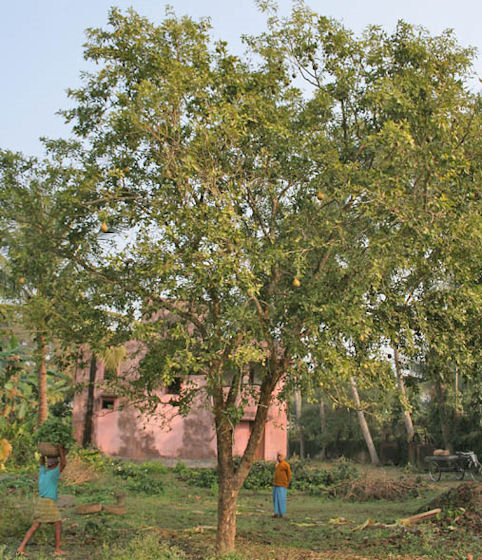
Abb.: Bilva = Aegle marmelos Corr. = Bael,
Narendrapur (নরেন্দ্রপুর),
West Bengal
[Bildquelle: J. M. Garg, Wikipedia. GNU FD License]
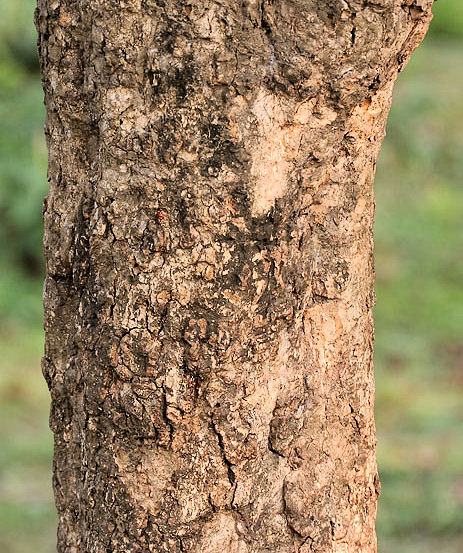
Abb.: Bilva = Aegle marmelos Corr. = Bael,
Narendrapur (নরেন্দ্রপুর),
West Bengal
[Bildquelle: J. M. Garg, Wikipedia. GNU FD License]
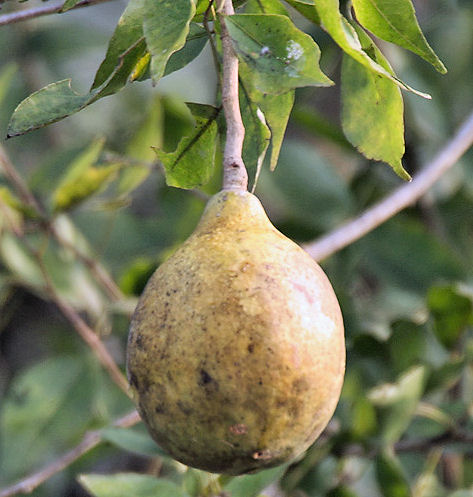
Abb.: Bilva = Aegle marmelos Corr. = Bael,
Narendrapur (নরেন্দ্রপুর),
West Bengal
[Bildquelle: J. M. Garg, Wikipedia. GNU FD License]
"Bael (Aegle marmelos) is a fruit-bearing tree indigenous to dry forests on hills and plains of central and southern India, southern Nepal, Sri Lanka, Myanmar, Pakistan, Bangladesh, Nepal, Vietnam, Laos, Cambodia and Thailand. It is cultivated throughout India, as well as in Sri Lanka, northern Malay Peninsula, Java and in the Philippines. It is also popularly known as Bilva, Bilwa, Bel, Kuvalam, Koovalam, Madtoum, or Beli fruit, Bengal quince, stone apple, and wood apple. The tree, which is the only species in the genus Aegle, grows up to 18 meters tall and bears thorns and fragrant flowers. It has a woody-skinned, smooth fruit 5-15 cm in diameter. The skin of some forms of the fruit is so hard it must be cracked open with a hammer. It has numerous seeds, which are densely covered with fibrous hairs and are embedded in a thick, gluey, aromatic pulp. The fruit is eaten fresh or dried. If fresh, the juice is strained and sweetened to make a drink similar to lemonade, and is also used in making sharbat, a refreshing drink where the pulp is mixed with tamarind. If the fruit is to be dried, it is usually sliced first and left to dry by the heat of the sun. The hard leathery slices are then placed in a pan with several litres of water which is then boiled and simmered. As for other parts of the plant, the leaves and small shoots are eaten as salad greens. The fruit is also used in religious rituals and as a ayurvedic remedy for such ailments as diarrhea, dysentery, intestinal parasites, dryness of the eyes, and the common cold. It is a very powerful antidote for chronic constipation.
In Hinduism, Lord Shiva is said to live under the Bael tree. In India, the tree is often found in temple gardens and its leaves are used in religious celebrations.
In the traditional culture of Nepal, the Bael tree is part of an important fertility ritual for girls known as the Bel baha.
This tree is a larval foodplant for the following two Indian Swallowtail butterflies, the Lime Butterfly Papilio demoleus and the Common Mormon Papilio polytes."
[Quelle: http://en.wikipedia.org/wiki/Aegle_marmelos. -- Zugriff am 2008-09-25]
2 Palāśa: Butea monosperma (Linn.) Kuntze = Malabar-Lackbaum = Flame of the Forest
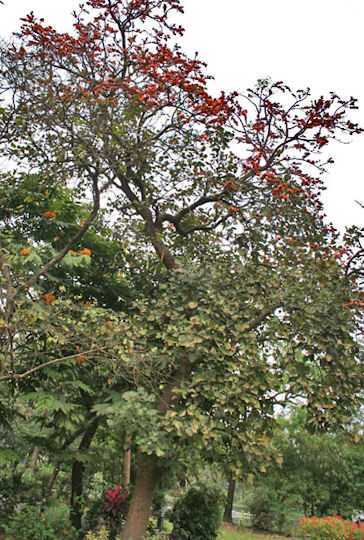
Abb.: Butea monosperma (Linn.) Kuntze =
Malabar-Lackbaum = Flame of the Forest, Kolkata (কলকাতা),
West Bengal
[Bildquelle: J. M. Garg, Wikipedia. GNU FD License]
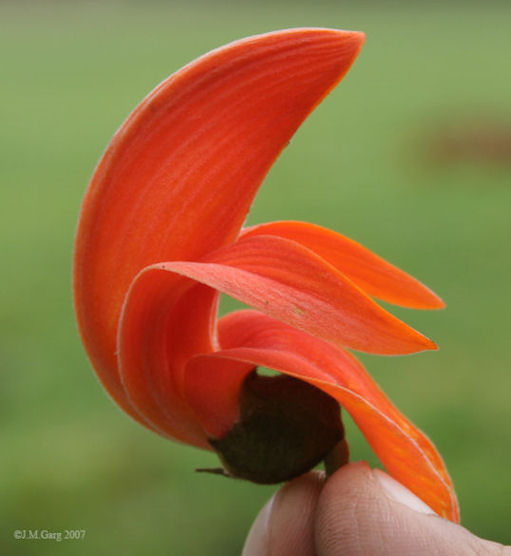
Abb.: Butea monosperma (Linn.) Kuntze =
Malabar-Lackbaum = Flame of the Forest, Kolkata (কলকাতা),
West Bengal
[Bildquelle: J. M. Garg, Wikipedia. GNU FD License]
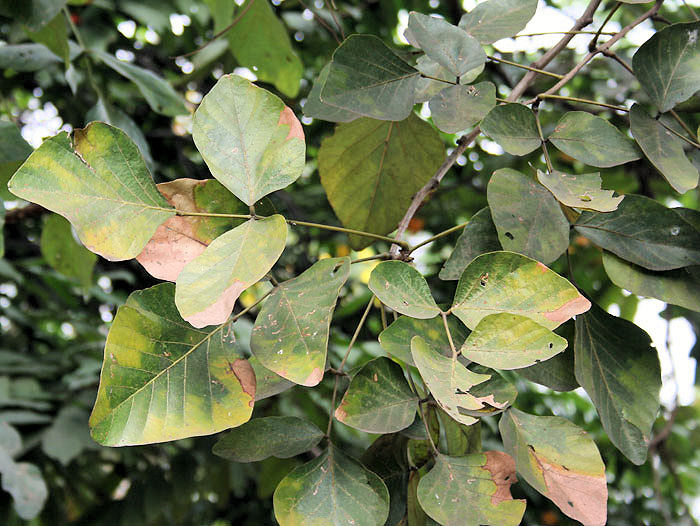
Abb.: Butea monosperma (Linn.) Kuntze =
Malabar-Lackbaum = Flame of the Forest, Kolkata (কলকাতা),
West Bengal
[Bildquelle: J. M. Garg, Wikipedia. GNU FD License]
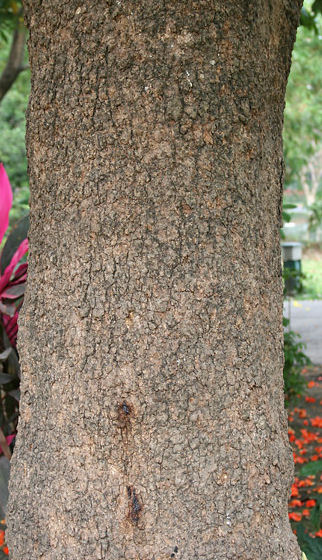
Abb.: Butea monosperma (Linn.) Kuntze =
Malabar-Lackbaum = Flame of the Forest, Kolkata (কলকাতা),
West Bengal
[Bildquelle: J. M. Garg, Wikipedia. GNU FD License]
"Der Malabar-Lackbaum, Palasabaum oder Plossobaum (Butea monosperma) ist ein kleinwüchsiger bis mittelgroßer Baum des indischen Subkontinents aus der Unterfamilie der Schmetterlingsblütler. Er ist bekannt für seine Fülle von orangeroten Blüten, die sehr früh im Jahr erscheinen und ihm den englischen Namen Flame of the forest eingebracht haben. Die Art dient neben anderen Arten als Futterpflanze der Lackschildlaus (Kerria lacca), deren Absonderung zur Herstellung von Schellack verwendet wird. Den Hindus gilt der Malabar-Lackbaum als heilig, das Holz wird zur Speisung des heiligen Feuers verwendet, zu Boden gefallene Blüten werden mit knienden Mönchen verglichen. Beschreibung
Der Malabar-Lackbaum ist ein kleinwüchsiger bis mittelgroßer Baum, der Wuchshöhen von 6 bis 12 Metern und auf nährstoffreichen Böden einen Stammdurchmesser (BHD) von bis zu 60 Zentimetern erreicht. Auf trockenen, nährstoffarmen Felsstandorten bleibt der Stamm kurz und krumm und die Äste sind unregelmäßig geformt. Auf den ärmsten Böden wächst die Art beinahe strauchartig.
Die Borke ist rissig, aschgrau oder braun bis schwärzlich und 1 bis 1,5 Zentimeter dick. Tiefere Schichten der Rinde sind weißlich bis rosa gefärbt und rot geadert. Das Phloem enthält einen roten, klebrigen Saft. Das Holz ist weich und zerstreutporig.
Die unpaarig gefiederten Laubblätter bestehen aus 10 bis 23 Zentimetern langen Stiele und drei ledrige Fiederblättchen. Das terminale Fiederblättchen ist 13 bis 20 Zentimeter lang und 11 bis 18 Zentimeter breit, und damit etwas größer als die Seitenfiedern mit Längen von 10 bis 15 Zentimetern und Breiten von 8 bis 10 Zentimetern. An der Unterseite sind deutlich die Blattadern zu erkennen. Die jungen Blätter erscheinen im April bis Anfang Mai. Zwischen November und Dezember werden die Blätter abgeworfen, einzelne Bäume behalten jedoch Blätter an den unteren Ästen.
Die Blüten sind in großer Zahl zu etwa 15 Zentimeter langen rispigen, axillar oder terminal angeordneten[1] Blütenständen zusammengefasst. Die Schmetterlingsblüten sind 2 bis 3 Zentimeter lang gestielt. Der Kelch ist außen samtig und innen seidig behaart und hat eine Länge von 1 bis 1,5 Zentimetern. Stiele und Kelche sind dunkel und kontrastieren stark zum flammenden Orangerot der Kronblätter. Die Krone besteht aus einer 2,5 Zentimeter langen Fahne, kleineren, wie ein Papageienschnabel geformten Flügeln und einem Schiffchen, das Stempel und Staubblätter umgibt. Die Blütezeit beginnt mit dem Erscheinen von Blütenknospen zwischen Januar und Februar an den noch kahlen Ästen und dauert bis zum Einsetzen der hohen Temperaturen zwischen März und April. Die Lebensdauer einer einzelnen Blüte beträgt ein bis zwei Tage[2].
Gleich nach der Blüte entwickeln sich die grünen, behaarten, 15 bis 20 Zentimeter langen und 3,5 Zentimeter breiten Hülsenfrüchte. Bei Reife im Mai und Juni sind die Früchte verholzt und von gelbbrauner Farbe, und fallen rasch zu Boden. Eine weiträumigere Verteilung durch Wind oder auf andere Art wurde nicht beobachtet[2]. Jede Frucht enthält einen runden, flachen, glänzenden Samen von 2 bis 3 Zentimeter Durchmesser und bitterem Geschmack.
Die Keimung ist hypogäisch und beginnt innerhalb der an der Spitze aufbrechenden Frucht. Die Sämlinge bilden eine Pfeilwurzel, die nach 3 Monaten eine Länge von 60 Zentimetern erreichen kann. Besonders kennzeichnend für den Malabar-Lackbaum ist das mehrmalige Absterben des Sprosses durch Frost oder Dürre, was zum Anschwellen der Wurzel führt und zum Neuaustrieb („dying back“-Phänomen). Die Pfahlwurzel dringt tief auch in felsiges Gestein ein und ist stark seitlich verzweigt. Die Wurzelrinde ist außen grau, dann rot und innen weiß. Frische Wurzeln haben einen deutlichen Geruch.
ÖkologieDie Blüten werden von einer Reihe von Vögeln besucht, die vom Nektar angelockt werden. Zur Bestäubung trägt jedoch nur der Purpurnektarvogel (Cinnyris asiaticus, synonym: Nectarinia asiatica) bei, der mit seinem langen Schnabel den Nektar erreichen kann, ohne die Blüte zu beschädigen. Andere Arten wie Rußbülbül (Pycnonotus cafer) oder der Ganges-Brillenvogel (Zosterops palpebrosa) konsumieren ebenfalls Nektar, müssen jedoch dazu den Blütenkelch beschädigen. Die Bestäubung kann auch durch das Dschungel-Palmenhörnchen (Funambulus tristriatus) erfolgen, da es mit seiner spitzen Schnauze ebenfalls den Nektar erreicht ohne Schaden anzurichten. Die Riesenhonigbiene (Apis dorsata) besucht die Blüten des Malabar-Lackbaums um nicht konsumierten Nektar an beschädigten Blüten aufzunehmen, trägt jedoch ebenfalls nicht zur Bestäubung bei.[2]
Der Malabar-Lackbaum ist eine Wirtspflanze der Lackschildlaus (Kerria lacca). Befruchtete Weibchen stechen die Rinde junger Zweige an und nehmen erhebliche Mengen Phloemsaft auf. Das von ihnen ausgeschiedene Sekret wird an den Zweigoberflächen fest und bildet Krusten, in welchen die stark angeschwollenen Läuse eingeschlossen werden und sterben. Wenige Woche später erfolgt das Ausschwärmen der neuen Läusegeneration.
Doch weder die Lackschildlaus noch andere saugende, blattfressende oder holzbohrende Insekten richten starken Schaden an. Der Malabar-Lackbaum leidet auch kaum an Pilzerkrankungen. Schwerwiegender sind Verluste am Jungwuchs durch Ratten, Stachelschweine und Schweine.
In tropischen Feuchtwäldern findet man den Malabar-Lackbaum zusammen mit dem Salbaum (Shorea robusta) oder mit Mallotus philippensis, in tropischen Trockenwäldern mit dem Teakbaum (Tectona grandis), dem Indischen Weihrauch (Boswellia serrata) oder der Duftenden Akazie (Acacia nilotica), in den tropischen Dornwäldern Nord-Indiens mit der Verek-Akazie (Acacia senegal) oder dem Khejribaum (Prosopis cineraria).
Verbreitung und StandortansprücheDer Malabar-Lackbaum wächst im Grasland, in Buschwäldern und schwach bewaldeten Gebieten Indiens, Burmas und Sri Lankas. Auf den Vorbergen des Himalaya trifft man ihn bis in Höhenlagen von 1200 Metern, in West- und Südindien bis 1100 Meter.
Im natürlichen Verbreitungsgebiet ist er minimalen Temperaturen zwischen 3°C und 18°C ausgesetzt, maximalen Temperaturen zwischen 35°C und 48°C. Als junger Baum ist diese Art empfindlich gegen Frost, die Frosthärte nimmt aber mit dem Alter zu. Als optimale jährliche Niederschlagsmenge gelten 750 bis 1500 Millimeter. Die Art ist besonders dürrehart und sehr anspruchslos bei der Standortwahl; sowohl staunasse als auch salzhaltige Standorte werden vertragen.
SystematikDie Erstbeschreibung unter dem Taxon Erythrina monosperma Lam. durch den französischen Botaniker Jean-Baptiste de Lamarck wurde 1786 veröffentlicht.[3] Der deutsche Botaniker Paul Hermann Wilhelm Taubert bezog sich 1894 auf dieses Basionym, ordnete die Art jedoch unter der Bezeichnung Butea monosperma in die Gattung Butea ein.[4] Ein weiteres Synonym für die Art ist Butea frondosa Roxb. ex Willd..
Der Gattungsname Butea erinnert an John Stuart, Earl of Bute, der damit für die Förderung botanischer Studien geehrt wird. Das Epithet monosperma leitet sich von der Tatsache ab, dass jede Frucht nur einen Samen enthält.
Man unterscheidet zwei Formen des Malabar-Lackbaums, Charka mit grauer Borke und Kareya mit dunkler Borke. Kareya wird besser von der Lackschildlaus angenommen und daher öfter zur Anzucht verwendet.
VerwendungWirtschaftlich bedeutungsvoll ist die Anzucht der Lackschildlaus zur Gewinnung des Ausgangsprodukts für Schellack. Zur Bewirtschaftung werden plantagenähnliche Bestände angelegt, in denen Bäume ab einen Stammdurchmesser von 15 bis 20 Zentimetern (BHD) 15 bis 20 Jahre lang genutzt werden können. Die Bäume werden zwei Mal im Jahr zurück geschnitten, um die Lackabsonderungen der Läuse zu ernten und den Neuaustrieb anzuregen. Nach der Ernte wird der Gummilack von den Zweigen gelöst, gewaschen, geschmolzen und zu Roh-Schellack weiterverarbeitet.
Das Holz (Handelsname: Dhak) ist leicht zu ernten, der Witterung ausgesetzt beträgt die Dauerhaftigkeit jedoch nur etwa 5 Monate, unter Wasser jedoch bedeutend länger. Als Nutzholz eignet es sich für billige Brettware und für die Errichtung von Brunnenschächten. Das Holz kann zu Holzkohle guter Qualität weiterverarbeitet werden, die zur Schießpulverherstellung geeignet ist.
Die aus Rindenverletzungen austretende Flüssigkeit verhärtet zu einer rubinroten, glasartigen Substanz, die als Bengalisches Kino bekannt ist. Es kann als Färbemittel für Wolle, Leder, Portwein oder Burgunder verwendet werden und dient als Ersatz für das Malabarkino, das von Pterocarpus marsupium gewonnen wird. Bengalisches Kino besteht zu über 70 % aus Tannin und zu etwa 20 % aus Gummi und anderen löslichen Stoffen[5].
Das Bengalische Kino wird in der Volksmedizin als Mittel gegen unterschiedliche Formen chronischer Verstopfung oder als Adstringens verwendet. Auch alle anderen Teile des Baumes werden volksmedizinisch eingesetzt, beispielsweise die zermahlenen Samen als Wurmmittel.
In verschiedenen Arten von Tempelgärten der Hindu symbolisiert der Malabar-Lackbaum unterschiedliche religiös bedeutende Himmelsobjekte. Im „Sternwald“, in dem 27 Sterne oder Sternformationen durch Büsche oder Bäume symbolisiert werden und entsprechend der Stellung am Sternenhimmel positioniert sind, steht der Malabar-Lackbaum für den Stern Theta Leonis aus dem Sternbild Löwe. Seine Position ist in etwa nach Nord-Osten ausgerichtet. Im „Neun-Planeten-Tempelwald“ repräsentiert der Malabar-Lackbaum den Mond, im „Tierkreiszeichen-Wald“ steht er für das Sternbild Krebs.[6]
Die Blätter werden als Futter für Wasserbüffel und Elefanten verwendet. Sie werden auch als Unterlage zum Servieren von Speisen eingesetzt.
Aus der Wurzelrinde lassen sich Fasern zur Herstellung grober Seile oder zur Abdichtung von Booten gewinnen.
Aufgrund der zahlreichen und schön gefärbten Blüten dient der Malabar-Lackbaum als Ziergehölz.
Quellen EinzelnachweiseLiteratur
- ↑ Beschreibung in Flora of Pakistan
- ↑ a b c R. Tandon et al.: Reproductivity of Butea monosperma (Fabaceae), Annals of Botany 92: 1-9, 2003 pdf (engl.)
- ↑ Encycl. 2:391. 1786.
- ↑ H. G. A. Engler & K. A. E. Prantl: Nat. Pflanzenfam. 3(3):366. 1894
- ↑ Henriette's Herbal Homepage: Butea Gum (Bengal Kino) (engl.)
- ↑ M. G. Chandrakanth et al: Temple forests in India's forest development. In: Agroforestry Systems, Volume 11, Nummer 3, September 1990. Seiten 199−211. doi:10.1007/BF00045899
- Schütt, Weisgerber, Schuck, Lang, Stimm, Roloff: Bäume der Tropen, 2006, ISBN 3-933203-79-1
[Quelle: http://de.wikipedia.org/wiki/Malabar-Lackbaum. -- Zugriff am 2008-09-25]
3 Vaṭa: Ficus bengalensis L. = Ficus benghalensis L. = Banyan-Feige, Banyan

Abb.: Vaṭa = Ficus bengalensis L. = Ficus
benghalensis L. = Banyan-Feige, Banyan
[Bildquelle: Ahoerstemeier
, Wikipedia. GNU FD License]
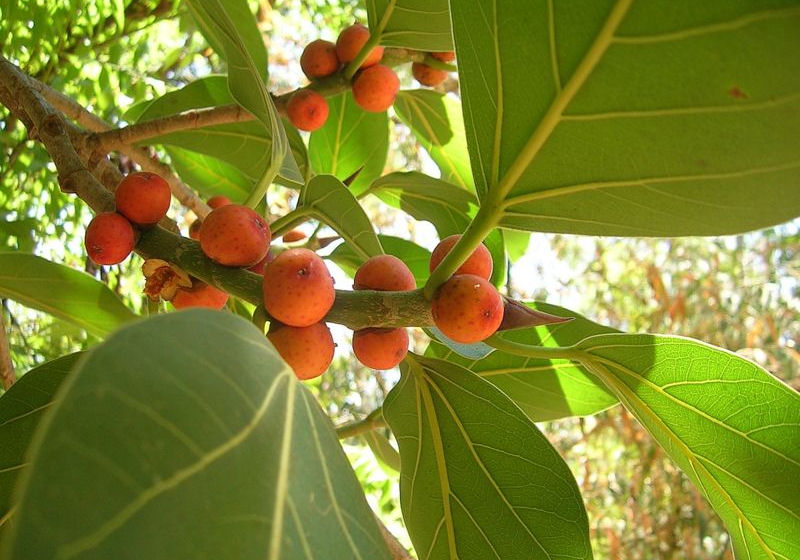
Abb.: Vaṭa = Ficus bengalensis L. = Ficus
benghalensis L. = Banyan-Feige, Banyan, Karnataka
[Bildquelle: L. Shyamal,
Wikipedia. GNU FD License]

Abb.: Vaṭa = Ficus bengalensis L. = Ficus
benghalensis L. = Banyan-Feige, Banyan
[Bildquelle: Wikipedia. Public domain]
"Die Banyan-Feige (Ficus benghalensis), auch Banyanbaum oder Bengalische Feige genannt, ist eine Art der Untergattung Urostigma aus der Gattung der Feigen (Ficus) in der Familie der Maulbeergewächse (Moraceae). Die Art, ursprünglich in Süd- und Westindien beheimatet, ist mittlerweile in den gesamten Tropen zu finden. Fälschlicherweise werden auch andere Arten der Untergattung Urostigma, z.B. die Großblättrige Feige, gelegentlich als Banyanbaum bezeichnet. Beschreibung
Der Banyan wächst epiphytisch auf einem beliebigen Wirtsbaum, der zunächst keinen Schaden nimmt, da der Banyan kein Schmarotzer ist. Er sendet Luftwurzeln aus, die sich mit der Zeit zu einem dichten Netz entwickeln. Haben die Wurzeln den Boden erreicht, kommt es zu einem Wachstumsschub, da die Pflanze nun nicht mehr ausschließlich auf das Substrat, das sich auf dem Wirtsbaum angesammelt hat, angewiesen ist. Mit zunehmendem Wachstum wird der Wirtsbaum erdrückt und stirbt schließlich ab.
Banyanbäume können gewaltige Dimensionen erreichen. Sie werden über 30 Meter hoch. Die zunehmende Zahl der Luftwurzeln entwickelt sich zu mehreren Stämmen mit zum Teil beträchtlichem Umfang. Auf diese Weise kann der Banyanbaum mit der Zeit eine Bodenfläche von mehreren Hundert Quadratmetern bedecken. Der außergewöhnlich umfangreiche Baum in dem untenstehenden Bild hat eine mannsgroße Öffnung und wird als Portal zu einem Dorf benutzt.
Der Banyanbaum hat große, ledrige Blätter. Nebenblätter sind ausgebildet, pro Blatt jedoch nur ein Nebenblatt wie bei allen Ficus-Arten (es wird aber entwicklungsgeschichtlich auch aus zwei Nebenblättern durch Verwachsung gebildet). Blüten und Früchte sind nur unscheinbar. Die Feigen werden gerne von Vögeln gefressen, was zur Verbreitung der Bäume über den Vogelkot beiträgt. Das Holz ist nur von geringem wirtschaftlichen Nutzen.
Bei vielen Völkern gilt der Banyanbaum als Sitz von Geistern. Die Batak auf der Insel Sumatra pflanzen Banyanbäume in der Nähe ihrer Dörfer, um den Geistern ihrer Ahnen eine Wohnstätte zu bieten.
In Indien wird der Banyanbaum als heiliger Baum verehrt. Sein Holz wird für die im hinduistischen Glauben übliche Verbrennung der Toten verwendet.
Ein naher Verwandter des Banyan ist der Bodhi-Baum (Ficus religiosa), der in Indien und Sri Lanka als Ort der Erleuchtung Buddhas verehrt wird."
[Quelle: http://de.wikipedia.org/wiki/Banyan-Feige. -- Zugriff am 2008-09-25]
4 Khadira: Acacia catechu Willd. = Mimosa catechu L. f. = Gerber-Akazie = Cachou Acacia
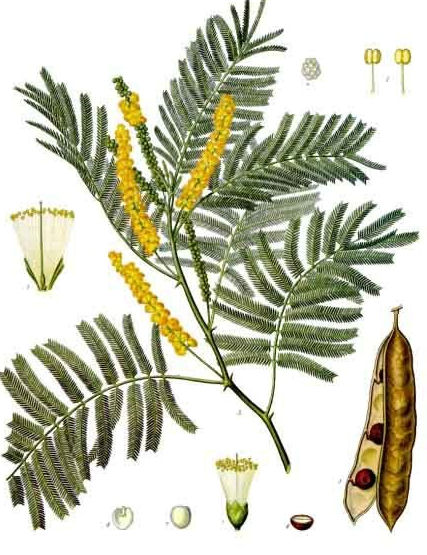
Abb.: Khadira = Acacia catechu Willd. = Mimosa
catechu L. f. = Gerber-Akazie = Cachou Acacia
[Bildquelle: Köhler, ©1887]
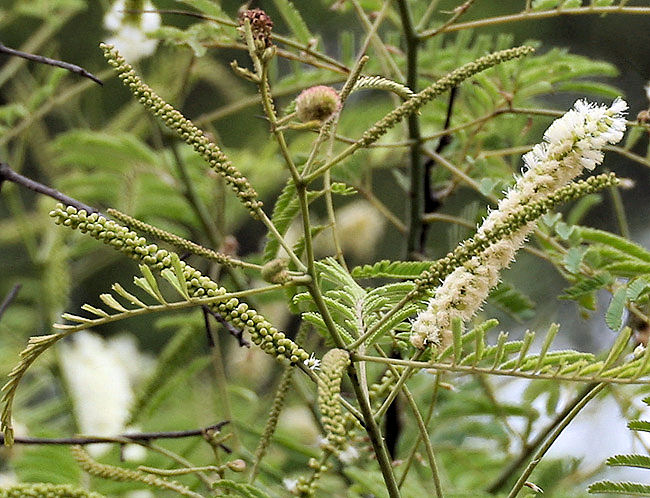
Abb.: Khadira = Acacia catechu Willd. = Mimosa
catechu L. f. = Gerber-Akazie = Cachou Acacia, Hyderabad (హైదరాబాదు),
Andhra Pradesh
[Bildquelle: J. M. Garg, Wikipedia. GNU FD License]
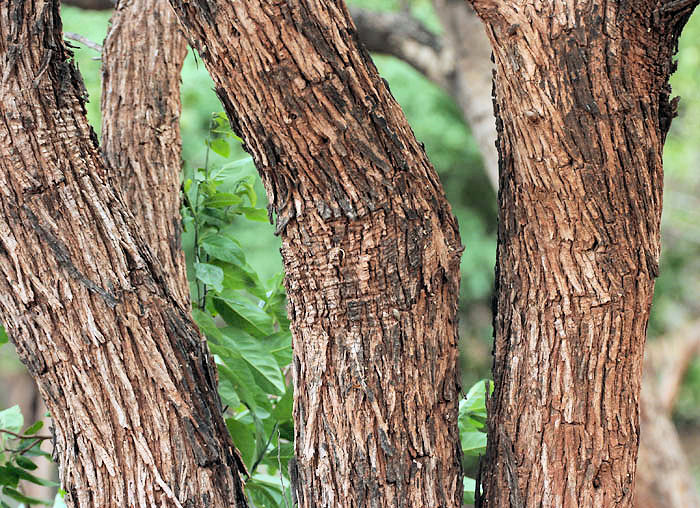
Abb.: Khadira = Acacia catechu Willd. = Mimosa
catechu L. f. = Gerber-Akazie = Cachou Acacia, Hyderabad (హైదరాబాదు),
Andhra Pradesh
[Bildquelle: J. M. Garg, Wikipedia. GNU FD License]
"Die Gerber-Akazie (Acacia catechu), manchmal auch Katechu-Akazie oder nur Katechu genannt, ist eine in Südasien beheimatete kleine Art der Gattung der Akazien (Acacia).[1] Sie hat paarige, hakenförmige Zweige sowie paarig gefiederte Blätter. Den weißen bis gelben Blüten, die sich zu viert in 10 cm großen Ähren drängen, folgen flache Hülsen.
Aus der Rinde kann man eine adstringierende Substanz gewinnen, die in der Medizin und zum Gerben eingesetzt wird. Die Droge der Pflanze wird medizinisch bei Diarrhöe und Entzündungen der Mundhöhle eingesetzt.
Der Catechubaum oder auch indische Gerbakazie spielt eine wichtige Rolle in der Kosmetik: er liefert ein hellbraunes Pulver zum Haarfärben (Pflanzenhaarfarbe).
Die Pflanze ist in Mitteleuropa nicht winterhart.
SynonymeQuellen
- Acacia catechu (L. f.) Willd. var. catechuoides (Roxb.)Prain
- Acacia catechuoides (Roxb.) Benth.
- Acacia sundra (Roxb.) Bedd.
- Acacia wallichiana DC.
- Mimosa catechu L. f.
- Mimosa catechuoides Roxb.[1]
- ↑ a b International Legume Database & Information Service (ILDIS)"
[Quelle: http://de.wikipedia.org/wiki/Gerber-Akazie. -- Zugriff am 2008-09-25]
5 Pīlu: Salvadora persica Linn. = Zahnbürstenbaum = toothbrush tree
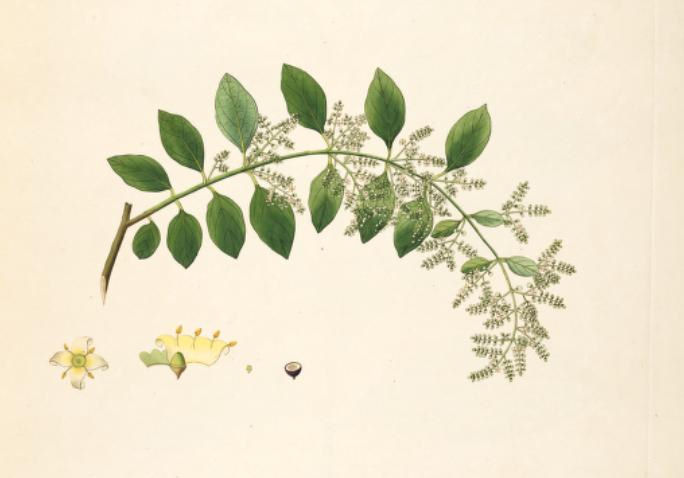
Abb.: Pīlu = Salvadora persica Linn. =
Zahnbürstenbaum = toothbrush tree
[Bildquelle: Plants of the coast of Coromandel 1793; Wikipedia; Public domain]
"Der Zahnbürstenbaum (Salvadora persica, Syn.: Galenia asiatica, Salvadora indica) ist eine Pflanzenart, die zur kleinen Familie der Salvadoraceae in der Ordnung der Kreuzblütlerartigen (Brassicales) gehört. Andere Trivialnamen sind Salzbusch, Senfbaum und Arrakbaum oder Arakbaum. Verbreitung
Diese Pflanzenart kommt heute in Afrika und Indien vor. Sie ist in manchen Trockengebieten eine eingebürgte Art. Salvadora persica gedeiht auf sandigen, trockenen Standorten oder salzhaltigen Böden. Eine typische Strandpflanze ist sie aber nicht. In Indien wächst sie in Höhenlagen bis 500 Meter und in Tansania kommt sie bis in Höhenlagen von 1800 Meter vor.
BeschreibungSalvadora persica ist ein immergrüner, schnell wachsender Strauch oder kleiner Baum, der Wuchshöhen von 2,7 bis 6 m erreicht, mit hängenden Ästen und charakteristischen, über die ganze Pflanze verteilten, langen Knospen. Die gestielten, länglich-ovalen oder eiförmigen, steifen und fleischigen Laubblätter sind 1,4 bis 10,5 cm lang und 1,2 bis 3 (selten bis 7,5) cm breit. Die Kutikula der Blätter ist ziemlich dick. Die Blätter sind isolateral gebaut und die nicht eingesenkten Spaltöffnungen befinden sich auf beiden Blattseiten. Die Gefäßendigungen sind von zahlreichen Speichertracheiden umgeben. Die Blätter haben ein Wasserspeichergewebe. Die Blattstiele sind 0,3 bis 1,3 (selten bis 2) cm lang.
Die achsel- oder endständigen, zusammengesetzten, rispigen Blütenstände bestehen aus traubigen Teilblütenständen und sind bis zu 10 cm lang. Die kleinen, vierzählig Blüten sind grünlich-weiß. Pro Blüte sind zwei Fruchtblätter vorhanden. Der Stempel ist nur kurz.
Die erbsenförmigen, schmalen und runden Früchte werden bei Reife rot oder dunkelviolett; sie enthalten nur einen Samen.
NutzungSeinen Namen verdankt der Zahnbürstenbaum der Tatsache, dass seine Knospen, Wurzeln und Zweige traditionell zur Zahnpflege verwendet werden. Dazu werden sie abgeschnitten und anschließend solange gekaut, bis ein Ende so ausgefranst ist, dass es an eine Bürste erinnert. Anschließend werden damit die Zähne geputzt, wobei die abbrechenden Holzstücke ausgespuckt werden. Diese Zahnhölzer dienen zum Reinigen der Zähne, als Zungenschaber und zur Massage des Zahnfleisches. Man findet bei den Islamischen Sitten zur Gebetsverrichtung folgende Erwähnung: "... Die erforderlichen Vorschriften des Gebetes nach der Rechtsschule Hanefi sind im folgenden: Zahnbürste aus Zahnbürstenbaum zu benutzen. ...". Diese natürliche Zahnbürste wird auch Miswak oder Siwak genannt.
In der Pflanze sind wichtige Mineralstoffe, Rohfasern, Proteine und keimhemmend wirkende Substanzen enthalten. Insbesondere Ablagerungen feinster Bassanit-Kristalle unterstützen die Reinigung der Zähne durch das Kauen der Pflanzenteile. Die Hölzer enthalten einen hohen Fluorid-Anteil von 8 bis 22 ppm.
Ayurvedische Kräuterzahnpasta enthalten Wirkstoffe aus dieser Art.
Die Blätter und Rinde enthalten Trimethylamin. Die Samen sind reich an Ölen und organischen Säuren.
ÖkologieEs ist die Nahrungspflanze für die Schmetterlings-Arten (Lepidoptera): Charaxes hansali, Colotis phisadia, Colotis vestalis, Nepheronia buquetii.
Quellen
- B. Verdcourt: Salvadora persica L. in Flora of Tropical East Africa, 1968. Online bei Aluka. (engl.)"
[Quelle: http://de.wikipedia.org/wiki/Salvadora_persica. -- Zugriff am 2008-09-25]
6 Udumbara: Ficus glomerata Roxb. = Ficus racemosa L. = Cluster Fig
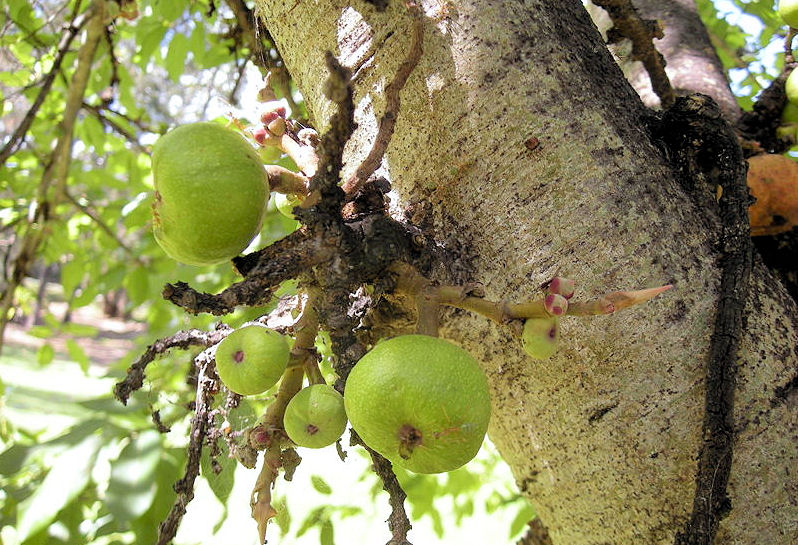
Abb.: Udumbara = Ficus glomerata Roxb. = Ficus
racemosa L. = Cluster Fig
[Bildquelle: Ethel Aardvark, Wikipedia;  Creative Commons Lizenz
(Namensnennung)]
Creative Commons Lizenz
(Namensnennung)]
"Ficus racemosa (syn. Ficus glomerata Roxb.) is a species of plant in the Moraceae family. Popularly known as the Cluster Fig Tree or Goolar Fig, this is native to Australasia, South-East Asia and the Indian Subcontinent. it is unusual in that its figs grow on or close to the tree trunk." [Quelle: http://en.wikipedia.org/wiki/Ficus_racemosa. -- Zugriff am 2008-09-25]
keśāntiko brāhmaṇasya
daṇḍaḥ
kāryaḥ pramāṇataḥ |
lalāṭasammito rājñaḥ
syāt tu nāsāntiko viśaḥ |46|
46. In der Länge soll der Stab eines Brahmanen bis einschließlich dem Kopfhaar verfertigt werden, der eines Adligen soll bis zur Stirn reichen, der eine Vaiśya bis zu Nase.
ṛjavas te tu sarve syur
avraṇāḥ saumyadarśanāḥ |
anudvegakarā nṝṇāṃ
satvaco 'nagnidūṣitāḥ |47|
47. Alle diese Stöcke sollen gerade sein, ohne Wunden, freundlich anzuschauen, Menschen nicht erschreckend, mit Rinde, nicht von Feuer verdorben1.
Erläuterungen:
Bühler (S.B.E.):
"47. Anudvegakarāḥ, 'not likely to terrify anybody' (Medhātithi, Govindarāja, Kullūka), means according to Nārāyaṇa 'not causing displeasure (to the wearer) by faults such as roughness.'"
1 nicht von Feuer verdorben: d.h. nicht durch Feuer gehärtet (wie z.B. Pfeilspitzen)
pratigṛhyepsitaṃ daṇḍam
upasthāya ca bhāskaram |
pradakṣiṇaṃ parītyāgniṃ
cared bhaikṣaṃ yathāvidhi |48|
48. Er nehme den den gewünschten Stock entgegen, verehre die Sonne, gehe mit seiner rechten Seite1 gegen das Feuer gerichtet um dieses und gehe dann ordnungsgemäß auf Almosengang.
Erläuterungen:
Bühler (S.B.E.):
"48-57. Āp. I, 3, 25-4, 4; Gaut. II, 35-41; Vas. XI, 68-70; Baudh. I, 3, 16-18; Vi. XXVII, 25 ; Yājñ. I, 30; 51-57. Āp. II, I, 2-3; 3,11; Gaut. IX, 59; Vas. Ill, 69; XII, 18-20; Baudh. II, 5, 18, 21-6, 2; 13, 12 ; Vi. LVIII, 34-35, 40-44; Yājñ. I, 27, 31, 112."
1 mit seiner rechten Seite: pradakṣina
bhavatpūrvaṃ cared bhaikṣam
upanīto dvijottamaḥ |
bhavanmadhyaṃ tu rājanyo
vaiśyas tu bhavaduttaram |49|
49. Der Höchste der Zweimalgeborenen, der Upanayana empfangen hat, soll um Almosen bitten mit dem Wort "Bhavat" am Anfang, ein Adliger mit "Bhavat" in der Mitte, ein Vaiśya mit "Bhavat" am Ende1.
Erläuterungen:
1 Bhavat am Anfang ... in der Mitte ... am Ende: da man Frauen bittet, muss die weibliche Vokativform "bhavati" verwendet werden:
D.h.:
Medhātithi:
"Question.—" Wherefore could there be any possibility of Sanskrit words being used, since they are addressed to women, and they do not understand Sanskrit ?'' Answer.—The Initiatory ceremony, being compulsory, is of an eternal character ; and it is in connection with this ceremony that the use of the words is laid down. The vernaculars (corrupt languages) are not eternal ; so that there could be no connection between these and an eternal ceremony. Then again, just as when educated people hear corrupt forms of words used, they are reminded, by the resemblance, of the corresponding correct forms and thereby come to comprehend the meaning ; -for instance, the (incorrect) word 'gā' leads to the inference (remembrance of) of the (correct) word 'go' through similarity, according to the theory that 'the incorrect word is expressive only by inference, and the meaning is comprehended from the inferred correct word in the same manner when correct words are addressed to women, they remember, through similarity, the corresponding incorrect words whoso meaning they know, and thus they come to comprehend the meaning of the words used. Further, the expression in question is a short one consisting of three words only, and these being well known words, they would be easily comprehensible by ladies also."
[Übersetzung: Manu-smrti ; the laws of Manu with the bhāsya of Mēdhātithi / translated by Gangā-nātha Jhā [1871 - 1941]. -- [Calcutta] : University of Calcutta, 1920-26. -- Bd. III,1. -- S. 288f.]
mātaraṃ vā svasāraṃ vā
mātur vā bhaginīṃ nijām |
bhikṣeta bhikṣāṃ prathamaṃ
yā cainaṃ nāvamānayeta |50|
a Olivelle: vimānayet
50. Zuerst bitte er um Almosenspeise seine Mutter oder seine Schwester oder seiner Mutter eigene Schwester bzw. eine Frau, die ihn nicht blamiert1.
Erläuterungen:
1 die ihn nicht blamiert: Kausativ: "nicht verächtlich machen"
Medhātithi:
"'As may not insult him'—'insulting' here means disregard ; i.e., refusal—'I shall give nothing.' Says the Grhya-sutra—' He should beg from such man or woman as may not refuse him.' What is meant here by 'first' is the begging that is done by the boy during Initiation. In the course of the subsequent daily begging, he should not fear refusal."
[Übersetzung: Manu-smrti ; the laws of Manu with the bhāsya of Mēdhātithi / translated by Gangā-nātha Jhā [1871 - 1941]. -- [Calcutta] : University of Calcutta, 1920-26. -- Bd. III,1. -- S. 294.]
samāhṛtya tu tad bhaikṣaṃ
yāvad artham amāyayā |
nivedya gurave 'śnīyād
ācamya prāṅmukhaḥ śuciḥ |51|
51. Nachdem er diese Almosenspeise gesammelt hat soviel wie nötig ist und sie seinem Lehrer ehrlich angeboten hat, soll er sie essen mit nach Osten gerichtetem Gesicht, rein nachdem er Wasser geschlürft hat.
Erläuterungen:
Medhātithi:
"The term 'having collected' shows that the food should be obtained from several ladies, and a large quantity should not be obtained from a single lady. 'It'—refers to that which has gone immediately before this, i.e., the food begged for ordinary eating, and not that which is done as part of the Initiation-rites, with which the context deals ; specially as with regard to the latter all that the Gṛhya-Sutra prescribes is that the food should be 'cooked,' and nothing is said regarding 'eating.' Further, the injunction that 'the boy should fast for the rest of the day' shows that the boy undergoes the Initiatory rite after breakfast; so that the actual eating of the food cannot be part of that rite.
'As much as way be needed';—i.e., just as much food as may be necessary for the satisfaction of hunger; large quantities of food should not be begged.
'Having offered it without guile to the Teacher;'—i.e., he should not show the teacher only the inferior articles of food, hiding with these the superior ones, with the view that the Teacher would not take any thing out of the inferior articles. The 'offering' consists of presenting it to him, saying 'this is what I have obtained.'
What the teacher does not take, 'he should eat,' after having been permitted by the teacher to do so.
"Why should not the offering be regarded merely as an act producing in the food some transcendental effect (and not as a real offering meant to be accepted by the teacher) ?"
That it is not so is proved by historical evidence : says the revered Vyāsa in the story of Hṛtakūpa, where it is distinctly stated that the teacher actually took what was offered.
[...]
'Pure'—This means that after rinsing the mouth he should avoid, during meals, such things as looking at the Caṇḍāla going to unclean places, spitting and so forth."
[Übersetzung: Manu-smrti ; the laws of Manu with the bhāsya of Mēdhātithi / translated by Gangā-nātha Jhā [1871 - 1941]. -- [Calcutta] : University of Calcutta, 1920-26. -- Bd. III,1. -- S. 294ff.]
āyuṣyaṃ prāṅmukho bhuṅkte
yaśasyaṃ dakṣiṇāmukhaḥ |
śriyaṃ pratyaṅmukho bhuṅkte
ṛtaṃ bhuṅkte hya udaṅmukhaḥ |52|
a Olivelle om.
52. Denn1 nach Osten gerichtet isst manLanglebigkeit, nach Süden gerichtet Ruhm, nach Westen gerichtet Wohlstand, nach Norden gerichtet Wahrheit.
Erläuterungen:
Bühler (S.B.E.):
"52. Medhātithi and Nārāyaṇa propose for ṛtam, 'truthfulness,' an alternative explanation, ' the sacrifice.'"
Medhātithi:
"The optional rule here laid down does not apply only to the Religious Student, nor to the eating of the food obtained by begging only, but to all forms of eating by the Householder and others also. That this is so is indicated by the fact that though in the context we have all along had the Injunctive word 'aśnīyāt,' the present verse has used a different word 'bhuṅkte'; if the author had definitely intended the present rule to be as restricted in its application as those that have gone before, then he would have used the same word. When however we find him making use of a different word, 'bhuṅkte,' we begin to doubt if what is meant is the particular eating that has been hitherto dealt with in the context, or a general rule applying to all forms of eating; and the conclusion we are led to is that since a different verb is used, it must stand for a different act, and it cannot be regarded as the same that has been dealt with in the context. Some people have argued that—"in as much as there is no injunctive word in the present verse, it must be taken as merely laudatory of what has gone before." But this has been answered in Mīmāṃsā Sūtra 3. 5. 21 (where it is asserted that sentences laying down things not already known are to be regarded as injunctive). Nor do we find in the present verse any such signs as would indicate that it is meant to be subsidiary to the preceding verse,—such signs, for instance, as the fact of its being wanting in some integral part, if taken apart from the preceding verse, and so forth. It is possible to take the present verse as referring primarily to the Religious Student only, and then to extend its application to all men,—on the ground that what is laid down here is not incompatible with the duties of ordinary men, as the other duties of the Student are; but in that case the results mentioned in the verse would not accrue to the ordinary man. For authoritative writers (Mīmāṃsā Sūtra, 8. 1. 23, etc.) do not admit of activity by mere implied extension, in cases of special results following from the use of special accessory details. If such rules as 'for one desiring cattle, water should be fetched in the milking vessel 'the sacrificial post should be of khadira wood when the man desires vigour,' are never applied to the case of those sacrifices which are mere ectypes (of the Darshapurnamasa) ; and to which the details of the Darśapūrṇāmāsa become applicable by extended implication only."
[Übersetzung: Manu-smrti ; the laws of Manu with the bhāsya of Mēdhātithi / translated by Gangā-nātha Jhā [1871 - 1941]. -- [Calcutta] : University of Calcutta, 1920-26. -- Bd. III,1. -- S. 297f.]
1 Dieser Vers gibt die Begründung (hi) für den vorhergehenden: der frisch Zweimalgeborene soll nach Osten gerichtet essen, weil dies langes Leben bringt, die Grundlage für den Erwerb der anderen hier genannten Gaben (Wohlstand, Ruhm, Wahrheit). Für einen Neugeborenen ist der Wunsch nach langem Leben das Erstangemessene.
upaspṛśya dvijo nityam
annam adyāt samāhitaḥ |
bhuktvā copaspṛśet samyag
adbhiḥ khāni ca saṃspṛśet |53|
53. Stets soll ein Zweimalgeborener gesammelt essen, nachdem er zuvor Wasser geschlürft1 hat. Nach dem Essen schlürfe er in rechter Weise Wasser und berühre die Öffnungen [des Kopfes] mit Wasser.
Erläuterungen:
Bühler (S.B.E.):
"53. The word nityam, 'always,' indicates that this rule refers to householders also (Govindarāja, Kullūka, Nārāyaṇa, Nandana)."
1 geschlürft
Medhātithi:
"The terms 'ācamana' and 'spṛśa' are both synonymous, being found from the usage of cultured people, to signify a particular purificatory act. Though it is true that the root 'spṛśa' has been declared to have an entirely different meaning, and the root 'camu' (from which the word 'ācamana' is derived) also has been declared to signify the act of eating,—yet in actual usage we find that with the particular prefixes (upa and ā) they are used in a much restricted sense and hence they are taken in that (restricted) sense. So that even though the root ' spṛśa ' has a very wide denotation, yet actual usage limits its significance. [...] Hence the term 'upaspṛśya' means exactly what is meant by the term 'ācamya'; the actual injunction of this act of 'ācamana' will come later on. Further, the text itself uses the two terms as synonymous. Having laid down that 'one should always do the upasparśana,' it goes on to say that 'this ācamana' should be done three times ; from which it is clear that the two are synonymous. Though the 'rinsing of the mouth' has been already laid down in verse 51, it is re-iterated again in order to show immediate sequence: the sense being that one should take his food immediately after rinsing the mouth, and no other act should be allowed to intervene. To this end we have the following declaration of the revered Vyāsa—' Oh Lord, I shall remain with such people as take their food with five limbs wet'—this being said by Lakṣmī; the 'five limbs' being the two hands,
two feet, and mouth; and these five limbs can remain wet only if one eats immediately after the rinsing, and not if he makes any delay. Manu himself (in 4.76) is going to declare under the duties of the Snātaka that 'one should eat with the feet still wet'; and there we shall show that there is no needless repetition involved in this."[Übersetzung: Manu-smrti ; the laws of Manu with the bhāsya of Mēdhātithi / translated by Gangā-nātha Jhā [1871 - 1941]. -- [Calcutta] : University of Calcutta, 1920-26. -- Bd. III,1. -- S. 299f.]
pūjayed aśanaṃ nityam
adyāc caitad akutsayan |
dṛṣṭvā hṛṣyet prasīdec ca
pratinandec ca sarvaśaḥ |54|
54. Stets verehre er das Essen und esse es ohne daran herumzumäkeln. Wenn er das Essen sieht, freue er sich, sei abgeklärt und heiße es in jeder Hinsicht willkommen.
Erläuterungen:
Bühler (S.B.E.):
"54. 'Worship,' i.e. 'consider as a deity' (Medhātithi, Govindarāja, Nandana), or ' meditate on its being required to sustain life' (Medhātithi, Govindarāja, Kullūka), or 'praise it with the verse,' Ṛg-veda 1, 187, 1 (Nārāyaṇa)."
Medhātithi:
"'Food,' 'aśana,' is that which is eaten (aśyate), i.e., rice and curry, etc. When the food is brought to him, he should look upon it as a 'deity'; i.e., he should have the notion— 'this food is my highest deity.'
- The ' worshipping' of the food may consist in regarding it as the source of the birth and sustenance of all living beings;
- or (b) in regarding it as the means of sustaining his life; as the food is declared to have said—' he worships me regarding me as sustaining life';
- or (c) in receiving it with due obeisance, etc.
'He should eat it without disparaging it';—even when there is any such source of disparagement as that the article of food is of bad quality, or it is badly cooked, he should not disparage the food; i.e., he should not make any such disparaging remarks as—' this is most disagreeable,' or 'it is likely to upset the constitution of the body,' and so forth. If the food happens to be really defective, he should simply not eat it; he should not eat it and yet find fault with it.
'When he sees it he should rejoice ;'—he should rejoice just as he does when, on returning from a long journey, he sees his wife and children.
'He should feel gratified';—on seeing the food, he should remove from his mind even such displeasure as may have been produced by other causes.
'He should welcome it';—'welcoming' consists in acclaiming it as a boon; i.e., receiving it with honour, with such words as ' may we have such food every day.'
'Always,'—at all times. The affix 'śas' has the sense of the locative, according to the option involved in Pāṇini's Sutra 5. 4. 42. Or, we may read 'sarvadā' (instead of 'sarvaśaḥ')."
[Übersetzung: Manu-smrti ; the laws of Manu with the bhāsya of Mēdhātithi / translated by Gangā-nātha Jhā [1871 - 1941]. -- [Calcutta] : University of Calcutta, 1920-26. -- Bd. III,1. -- S. 302.]
pūjitaṃ hy aśanaṃ nityaṃ
balam ūrjaṃ ca yacchati |
apūjitaṃ tu tad bhuktam
ubhayaṃ nāśayed idam |55|
55. Denn stets verehrtes Essen gibt Kraft und Saft1. Wenn es unverehrt gegessen wird, dann vernichtet es beides.
Erläuterungen:
Bühler (S.B.E.):
"55. Ūrjam, 'manly vigour' (Govindarāja, Kullūka), or 'energy' (Nārāyaṇa, Nandana), or 'bulk' (Medhātithi)."
1 Kraft und Saft
Medhātithi:
"'Strength' is power, the capacity to lift heavy loads without effort; while 'vigour' stands for energy and courage, which is found even in a man who is lean (and physically weak) : while great strength is found only when the limbs of the body are well-developed and the body has attained huge proportions." [Übersetzung: Manu-smrti ; the laws of Manu with the bhāsya of Mēdhātithi / translated by Gangā-nātha Jhā [1871 - 1941]. -- [Calcutta] : University of Calcutta, 1920-26. -- Bd. III,1. -- S. 303.]
nocchiṣṭaṃ kasyacid dadyān
nādyād etat tathāntarā |
na caivātyaśanaṃ kuryān
na cocchiṣṭaḥ kvacid vrajet |56|
56. Er soll den Speiserest niemandem geben und er soll ihn auch nicht dazwischen1 essen. Er soll sich nicht überessen2 und er soll sich nirgendwo hinbegeben, wenn Speisereste an ihm sind.
Erläuterungen:
Bühler (S.B.E.):
"56. Medhātithi reads nādyād etat tathāntarā, and gives, besides the explanation adopted in the translation, two alternative interpretations: (1) 'let him not eat after interrupting his meal;' (2) 'let him not eat taking away his left hand from the dish.' Nandana reads nādyāc caitat tathāntarā, ' and let him not eat such a (remnant) given to him during (a meal by one of the company).'"
1 dazwischen
Medhātithi:
"The phrase 'antarā' 'in between,' means middle. There are two times for meals—morning and evening; and one should not eat between these meals. Or, 'in between' may mean interruption ; in which case the meaning is that 'having once left off the act of eating, and having interrupted it by some other act, he should not eat the food left in the same dish.' Another Smṛti lays down the specific rule that 'one should avoid eating interrupted by rising and washing.'
Others again have explained the phrase 'antarā,' as meaning disconnection. The Śruti having declared that 'holding the dish with the left hand, one should take up the morsel with the right hand and then offer it to the Life-breath in the mouth,'—it is the omitting of the act of holding the dish with the left hand, which is meant by the terms ' antarā.'"
[Übersetzung: Manu-smrti ; the laws of Manu with the bhāsya of Mēdhātithi / translated by Gangā-nātha Jhā [1871 - 1941]. -- [Calcutta] : University of Calcutta, 1920-26. -- Bd. III,1. -- S. 304.]
2 überessen: um keinen Speiserest übrig zu lassen
Vgl.
Carakasaṃhitā: Ausgewählte Texte aus der Carakasaṃhitā / übersetzt und erläutert von Alois Payer <1944 - >. -- 1. Sūtrasthāna. -- 5. Kapitel 5: "Maßvoll essend". -- Sūtra 1 - 13. -- URL: http://www.payer.de/ayurveda/caraka0105001.htm
Medhātithi:
"'He should not do over-eating';—one should not eat too much. This is with a view to health, and hence implies the avoidance of such food as may he either indigestible or unsuitable. Specially because the advice is based upon reason. What is 'over-eating' can be learnt from the Āyurveda. The sense is that one should eat only that quantity of food which does not quite fill the stomach, and which is properly digested. Of the three parts into which the stomach is divided, one part itself should be filled with food, half a part with water, and one part should be left for the action of the bodily humours. If this is not done, health suffers." [Übersetzung: Manu-smrti ; the laws of Manu with the bhāsya of Mēdhātithi / translated by Gangā-nātha Jhā [1871 - 1941]. -- [Calcutta] : University of Calcutta, 1920-26. -- Bd. III,1. -- S. 304f.]
anārogyam anāyuṣyam
asvargyaṃ cātibhojanam |
apuṇyaṃ lokavidviṣṭaṃ
tasmāt tat parivarjayet |57|
57. Überessen zerstört die Gesundheit und die volle Lebensspanne, verhindert den Himmel, ist schlecht, ist den Leuten verhasst -- darum vermeide er es.
brāhmeṇa vipras tīrthena
nityakālam upaspṛśet |
kāyatraidaśikābhyāṃ vā
na pitryeṇa kadācana |58|
58. Ein Brahmane soll immer seinen Mund und die Kopföffnungen spülen mit der Handlinie (tīrtha)1, die Brahmā geweiht ist, oder der, die Ka2 (Prajāpati) geweiht ist, oder der, die den 30 Göttern3 geweiht ist, niemals aber mit der den verstorbenen Vorfahren geweihten.
Erläuterungen:
Bühler (S.B.E.):
"58-62. Āp. I, 15, 1-16; Vas. Ill, 26-34; Baudh. I, 8, 12-23; Vi. LXII, 1-9; Yājñ. I, 18-21. 58. Though the text speaks of the Brāhmaṇa only, the rule refers, as the commentators remark, to other Āryans too."
1 Handlinie (tīrtha)
Medhātithi:
"The term 'tīrtha,' 'Receptacle,' means a clean vessel containing water; 'tīrtha' (literally) is that which exists for the purpose of saving people, i.e., freeing them from their sins. In some places 'tīrtha' is explained as ' that by which people descend into water.' In the present context however it stands for that part of the palm of the hand which contains water ; and we must take the word 'tīrtha' as applied to the hand, with a view to eulogise it, only figuratively ; for water does not remain in the hand always (and as such it cannot be called tīrtha in its literal sense)." [Übersetzung: Manu-smrti ; the laws of Manu with the bhāsya of Mēdhātithi / translated by Gangā-nātha Jhā [1871 - 1941]. -- [Calcutta] : University of Calcutta, 1920-26. -- Bd. III,1. -- S. 306.]
2 Ka
"ka m. eine Umbildung des Fragepronomens zum Namen eines obersten Gottes, des Prajāpati: der Wer, der Unbekannte. Die Benennung ist wahrscheinlich entstanden im Anschluss an den Refrain kasmai devāya haviṣā vidhema ṚV 10, 121, eines auch in VS. AV.TS. enthaltenen, offenbar berühmten und vielgebrauchten Liedes. Die Deutung auf den Gott ist hier und in vielen anderen Fällen aufgedrungen." [Quelle: Petersburger Wörterbuch, Bd. II, Sp. 6]
"PRAJĀ-PATI. 'Lord of creatures,' a progenitor, creator In the Veda the term is applied to Indra, Savitṛ, Soma, Hiraṇya-garbha, and other deities. In Manu the term is applied to Brahmā as the active creator and supporter of the universe; so Brahmā is the Prajā-pati. It is also given to Manu Svāyam-bhuva himself, as the son of Brahmā and as the secondary creator of the ten Ṛṣis, or " mind-born sons " of Brahmā, from whom mankind has descended. It is to these ten sages, as fathers of the human race, that the name Prajā-pati most commonly is given. They are
- Marīci,
- Atri,
- Aṅgiras,
- Pulastya,
- Pulaha,
- Kratu,
- Vasiṣṭha,
- Pracetas or Dakṣa,
- Bhṛgu, and
- Nārada.
According to some authorities the Prajā-patis are only seven in number, being identical with the seven great Ṛṣis. (See Rishi.) The number and names of the Prajā-patis vary in different authorities : the Mahā-bhārata makes twenty-one."
[Quelle: Dowson, John <1820-1881>: A classical dictionary of Hindu mythology and religion, geography, history, and literature. -- London, Trübner, 1879. -- s.v. ]
3 Dreißig Göttern:
Vermutlich die Bewohner des Himmels der 33 (Trayastriṃśa) ohne Prajāpati (dem ein andres tīrtha geweiht ist), und ohne ātman, d.h.
12 Āditya
10 Rudra:
8 Vasu
aṅguṣṭhamūlasya tale
brāhmaṃ tīrthaṃ pracakṣate |
kāyam aṅgulimūle 'gre
daivaṃ pitryaṃ tayor adhaḥ |59|
59. Die Handlinie auf der Handfläche an der Wurzel des Daumens heißt "dem Brahmā geweiht", die an der Wurzel der Finger "dem Ka geweiht", die an der Fingerspitze "den Göttern geweiht", die unterhalb beider "den verstorbenen Vorfahren geweiht".
Erläuterungen:
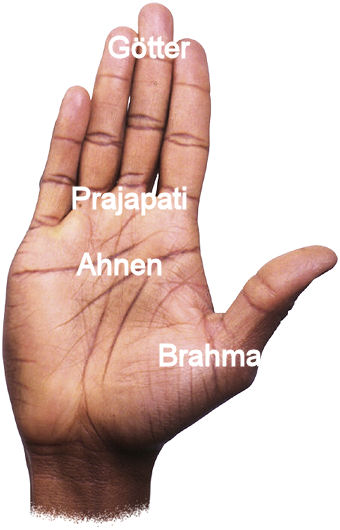
Abb.: Rechte Handfläche mit vermutlicher Lage der Tīrthas
[Bildquelle: ©Hemera]
Bühler (S.B.E.):
"59. Aṅgulimūle, 'at the root of the little finger' (Kullūka, Nārāyaṇa, Rāghāvananda), means according to Medhātithi and Nandana 'at the root of the fingers.'"
Medhātithi:
"The 'root' of the thumb is its lower part; and the part of the hand just below that root is the ' receptacle dedicated to Brahmā.'—The term 'tala' stands for the inner part (the palm). That inner portion of the hand which extends up to the long palm-line and faces one's own eyes is the part 'dedicated to Brahmā.' That at the root of the fingers, above the horizontal palm-line is 'dedicated to Prajāpati.'
'That on the tip of the fingers is dedicated to the Gods'— Even though the term 'aṅguli' forms the subordinate factor in the compound ('aṅguli-mūle'), yet it is construed with the term 'agre' for the simple reason that this latter is a relative term (and hence stands in need of a correlative).
'That below these two is dedicated to the Pitṛs.'—This also is to be construed with the terms 'aṅguli' and 'anguṣṭha' though both of these form subordinate factors in the two compounds. The 'finger' meant here is the index-finger. Hence it is the part below the thumb and the index-finger which is 'dedicated to the Pitṛs.'
We interpret the text in this manner on the strength of what is prescribed in other Smṛtis, and also upon that of the practices of cultured people; specially as no sense could be got out of the words as they stand. Says Śaṅkha—' Below the thumb and behind the first palm-line is the receptacle dedicated to Brahmā; that between the thumb and the index-finger is dedicated to the Pitṛs; that below the little finger is dedicated to Prajāpati, that at the tip of the fingers is dedicated to the Gods.'"
[Übersetzung: Manu-smrti ; the laws of Manu with the bhāsya of Mēdhātithi / translated by Gangā-nātha Jhā [1871 - 1941]. -- [Calcutta] : University of Calcutta, 1920-26. -- Bd. III,1. -- S. 308.]
trir ācāmed apaḥ pūrvaṃ
dviḥ pramṛjyāt tato mukham |
khāni caiva spṛśed adbhir
ātmānaṃ śira eva ca |60|
60. Zuerst schlürfe1 er dreimal Wasser, dann wische er zweimal den Mund ab, dann befeuchte er die Kopföffnungen, seine Seele2 und seinen Kopf.
Erläuterungen:
Bühler (S.B.E.):
"60. '(The seat of) the soul,' i. e. 'the heart' (all except Medhātithi, who adds, or 'the navel')."
1 schlürfe
Medhātithi:
"Through any one of the aforesaid ' receptacles' he should three times ' sip water,'—i.e., he should let water enter his stomach through the mouth." [Übersetzung: Manu-smrti ; the laws of Manu with the bhāsya of Mēdhātithi / translated by Gangā-nātha Jhā [1871 - 1941]. -- [Calcutta] : University of Calcutta, 1920-26. -- Bd. III,1. -- S. 309.]
2 Seele
Medhātithi:
"'The Soul'—stands for the Heart and the Navel. In the Upaniṣads we read that 'one should find the Soul in the heart.' Hence the 'touching of the heart' becomes the 'touching of the Soul,' the all-pervading entity ensouling the body. (We have to take it in this sense, because) there can be no touching of the Soul itself, which is something incorporeal. In some law-books it is laid down that 'one should touch the navel'; hence we have included 'navel' also (as indicated by the term 'Soul' of the text). 'Head'—this is well known. Since all Smṛtis are meant to serve the same purpose, 'the washing of hands up to the wrists' and such other acts (as
are laid down in Gautama 1.36, for instance) also have to be done along with those mentioned in the text; such acts, for instance, as not making noise, keeping silent, sprinkling of water on the feet—or even washing the feet, as laid down in the Mahābhārata."[Übersetzung: Manu-smrti ; the laws of Manu with the bhāsya of Mēdhātithi / translated by Gangā-nātha Jhā [1871 - 1941]. -- [Calcutta] : University of Calcutta, 1920-26. -- Bd. III,1. -- S. 309f.]
anuṣṇābhir aphenābhir
adbhis tīrthena dharmavit |
śaucepsuḥ sarvadācāmed
ekānte prāgudaṅmukhaḥ |61|
61. Ein Dharmakundiger, der Reinheit wünscht, soll immer mit einem Tīrtha Wasser schlürfen, das weder heiß1 noch schäumend ist, an einem einsamen Platz, mit dem Gesicht nach Osten oder Norden.
Erläuterungen:
Bühler (S.B.E.):
"61. 'Neither hot,' i. e. 'not boiled or heated on the fire ' (Medhātithi, Govindarāja, Kull, Nārāyaṇa, Nandana)."
1 heiß
Medhātithi:
"'Hot' here stands for boiled; elsewhere we read that the sipping should be done ' with unboiled water.' So that the prohibition does not apply to such water as is naturally hot, or has imbibed the heat of the hot atmosphere." [Übersetzung: Manu-smrti ; the laws of Manu with the bhāsya of Mēdhātithi / translated by Gangā-nātha Jhā [1871 - 1941]. -- [Calcutta] : University of Calcutta, 1920-26. -- Bd. III,1. -- S. 310.]
hṛdgābhiḥ pūyate vipraḥ
kaṇṭhagābhis tu bhūmipaḥ |
vaiśyo 'dbhiḥ prāśitābhis tu
śūdraḥ spṛṣṭābhir antataḥ |62|
62. Ein Brahmane wird gereinigt durch Wasser, das bis zum Herzen geht, ein Fürst durch solches, das bis zur Kehle geht, ein Vaiśya durch solches, das er in den Mund ausgenommen hat, ein Śūdra durch solches, das er oberflächlich berührt hat.
Erläuterungen:
Medhātithi:
"Water being a fluid substance, its going beyond the limits prescribed would be unavoidable; hence all that is meant is that if the water sipped fails to reach the prescribed limits, it fails to purify the man. The description of the 'receptacles' (parts of the hand) refers to the right hand; as it is this hand that should be used in all washings ; specially as it has been laid down that men should perform (religious) acts with the right hand. It is for this reason that we reiterate this fact in the present connection."
[Übersetzung: Manu-smrti ; the laws of Manu with the bhāsya of Mēdhātithi / translated by Gangā-nātha Jhā [1871 - 1941]. -- [Calcutta] : University of Calcutta, 1920-26. -- Bd. III,1. -- S. 313f.]
uddhṛte dakṣine pāṇāv
upavīty ucyate dvijaḥ |
savye prācīnamāvītī
nivītī kaṇṭhasajjane |63|
63. Wenn die rechte Hand oberhalb [des Upavīta] ist, nennt man einen Zweimalgeborenen "Upavītin", wenn die linke Hand oberhalb ist, "Prācīnamāvītin", wenn das Upavīta vom Hals herabhängt, "Nivītin".
Erläuterungen:
Bühler (S.B.E.):
"63. Baudh. I, 8, 5-10."
Medhātithi:
"As for the 'Prācīnavīta' method, this has been directly prescribed, in so many words, as pertaining to acts of offering to the Pitṛs ; so that when its use has been found in connection with these, it could not be taken as an alternative to the 'Upavīta' method, whose use has not yet been found. Similarly the 'Nivīta' method also has its use in connection with acts of sorcery. Though the use of the 'Nivīta' has not been laid down in the Manusmṛti itself, yet since all Smṛtis have the same end in view, the use prescribed in other Smrtis could be regarded as accepted in the present context also. The term 'hand' stands here for the arm ; it is only when the man raises his arm that he is called ' Upavīti'; further, we are going to point out later on that the 'Upavīta ' is the method (of wearing the thread) to be employed at all times (not during religious acts only); and no one is called ' Upavītin' by merely lifting his hand."
[Übersetzung: Manu-smrti ; the laws of Manu with the bhāsya of Mēdhātithi / translated by Gangā-nātha Jhā [1871 - 1941]. -- [Calcutta] : University of Calcutta, 1920-26. -- Bd. III,1. -- S. 315.]
mekhalām ajinaṃ daṇḍam
upavītaṃ kamaṇḍalum |
apsu prāsya vinaṣṭāni
gṛhṇītānyāni mantravat | 64 |
64. Wenn der Gürtel, das Fell, der Stab, das Upavīta, der Wassertopf unbrauchbar geworden oder verloren gegangen sind, nehme er mit Mantras andere.
Bühler (S.B.E.):
"64. Baudh. I, 6, 7; Vi. XXVII, 29."
Upanayana in den Gṛhyasūtras:
§ 24. Upanayana, die »Schulaufnahme« oder »Aufnahme beim Lehrer« (s. OLDENBERG, SBE. 29, S. 58, Anm. 1 und auch die Gesetzbücher Gautama 1, 5 ff., Āpastamba 1, 1, 19 ff., Manu 2, 46 usw.). Zeit der Aufnahme.
Die Aufnahme in den Unterricht findet für den Brahmanen im achten Jahre nach der Empfängnis statt.
- Śaṅkhāyana 2, 1, 3 gestattet auch das zehnte Jahr;
- Vaikhānasa 2, 3 nennt für einen brahmavarca-sakāma sogar das fünfte; für āyuṣkāma das achte, srīkāma das neunte Jahr (nach der Empfängnis).
- Āśvalāyana 1, 19, 1.. 2. und Pāraskara lassen die Wahl zwischen dem achten Lebensjahre und dem achten Jahr nach der Empfängnis.
- Hiraṇyakeśin 1, 1, 2 nennt das siebente Jahr.
Er, Vaikhānasa 2, 3 und Āpastamba 10, 4 geben als Jahreszeit den Frühling an.
Im elften Jahre des Lebens oder nach der Empfängnis tritt ein Kṣatriya in den Unterricht ein, nach Hiraṇyakeśin 1, 1, 4. Āpastamba 10, 4. Vaikhānasa 2, 3 im Sommer; im zwölften ein Vaiśya, nach Hiraṇyakeśin Āpastamba Vaikhānasa im Herbst
Doch kann die Aufnahme auch später stattfinden, je nach dem Familienbrauch (Pāraskara 2, 2, 4), denn bis zum 16. Jahr ist dazu die Zeit für einen Brahmanen nicht vorüber, für einen Kṣatriya nicht bis zum 22., für einen Vaisya nicht bis zum 24. (Āśvalāyana Gautama Pāraskara Śaṅkhāyana Vaikhānasa). Von da ab haben sie die Sāvitrī (das Lernen der Sāvitrī) und damit die Aufnahme verwirkt. Weder soll man sie als Schüler mehr aufnehmen, noch unterrichten, noch sie zum Opfer zulassen, noch mit ihnen verkehren (vy-ava-har) oder, wie Gautama 2, 10, 6 (vi-vah) sagt, sich mit ihnen verschwägern. Pāraskara fügt 2, 5, 42 noch die verschärfende Bestimmung hinzu, dass an die Nachkommenschaft solcher, die bis ins dritte Glied die Sāvitrī verwirkten, Sakramente (Saṃskāra's) und Unterricht nicht erteilt werden dürfen, und es bedarf erst des Vrātyastomaopfers. (Kātyāyana Śrautasūtra 22, 4, 2; cf. STENZLER'S Anmerkung zu Pāraskara — Vaikhānasa schreibt zur Reinigung den Uddālakahoma, ein Aśvamedhabad oder den Vrātyastoma vor —), um sie zu reinigen und zuzulassen.
Aufnahmefest. — Am Tag der Aufnahme, der nach Hiraṇyakeśin 1, 1, 5 in der zunehmenden Monatshälfte, unter einem glücklichen Sternbild, besonders solchem mit männlichem Namen (so auch Vaikhānasa 2, 5) liegen soll, wird der Knabe geschoren, gebadet und geschmückt, auch gespeist (Gautama 2, 10, 7; Hiraṇyakeśin 1, 1, 7) und mit einem frischen Gewande angetan.
Auch Brahmanen, nach Hiraṇyakeśin 1, 1, 6 in grader Zahl, werden bewirtet (Pāraskara, Hiraṇyakeśin, Āpastamba) und zu Segenswünschen veranlasst.
Auf einem nach Ost, Nord oder Nordost geneigten oder ebenen Platz (Hiraṇyakeśin 1, 1, 9; »vor der Hütte« Gautama 2, 10, 15) brennt ein Feuer, das entweder durch Reiben erzeugt oder gewöhnlichem Feuer entnommen ist (Hiraṇyakeśin). Nach Āpastamba 11, 20 wird dies Feuer durch drei Tage bewahrt, also solange, als nach einigen Sūtren (Āpastamba 11, 20. 21. 26. Hiraṇyakeśin 1, 8, 1. 7) die feierliche Zeit des Upanayana dauert.
An diesem Feuer, hinter dem Lehrer und Schüler stehen, der Lehrer mit dem Gesicht nach Osten, der Schüler nach Westen (Āśvalāyana 1, 20, 2; 2, 1, 28; etwas anders Gautama 2, 10, 17), geht die Zeremonie vor sich. Das Stehen betont Śaṅkhāyana 2, 1, 29 noch besonders.
Sehr ausführlich ist die Beschreibung bei Hiraṇyakeśin, der hier zugleich den Typus eines Darvihoma schildert.
Die Reihenfolge der Zeremonien weicht in den Sūtren mehrfach ab; es wird genügen, im Wesentlichen Hiraṇyakeśin zu folgen.
Südlich vom Feuer streut er Darbhagras auf den Sitz für den Brahman und nimmt mit zwei Sprüchen des Yajurveda. (»in mich nehme ich zuerst Agni auf usw.«; »Welcher Agni, o Manen, in unsre Herzen eingegangen ist usw.«) Agni in sich auf (cf. Kātyāyana 17, 3, 27).
Nördlich vom Feuer werden die notwendigen Utensilien hin gelegt,
- ein Stein (nur Hiraṇyakeśin 1, 7,17; 3, 14; Āpastamba, Vaikhānasa, Kauśika);
- ein frisches Kleid und
- ein Fell;
- Gürtel;
- Stab und
- 21 Stücke Holz oder soviel als Darbringungen zu machen sind; darauf bindet er die Paridhi's.
Kleid und Fell. — Hiraṇyakeśin (l, I, 16; 4, 2) spricht nur von einem »ungebrauchten« (ahata) Kleid; Āpastamba 10, 10 von einem, das an demselben Tage gesponnen und gewoben ist; Gautama (2, 10, 8. 12) von »leinen, hänfenen, baum- und schafwollenen Kleidern«, von denen die beiden ersten für den Brahmanen, das baumwollene für den Kṣatriya, das aus Schafwolle für den Vaiśya bestimmt ist. Āśvalāyana l, 19, 9 von einem rotgefärbten (kāṣāya) Kleide für den Brahmanen, einem krapproten (māñjiṣṭha) für den Kṣatriya und einem gelben (hāridra) für den Vaiśya, im Fall sie Gewänder anlegen sollten; nach einer Bemerkung des Komm., die mir nicht in Einklang mit dem Text zu sein scheint, würden gefärbte Gewänder nicht notwendig sein. (Vgl. auch die Gesetzbücher Gautama 1, 17 usw.).
Das Obergewand bildet ein Fell. Nur Āpastamba 10, II spricht allgemein von einem Fell (ajina), während alle andren genauere Unterschiede machen und für den Brahmanen das Fell einer schwarzen Antilope (krṣṇājina, aiṇeya), von einem Ruruhirsch (raurava) für den Kṣatriya, ein Ziegen- oder Kuhfell für den Vaiśya vorschreiben. Wenn das gewünschte nicht da ist, so kann nach Pāraskara (2, 5, 20) für alle ein Kuhfell verwendet werden, weil das »das beste von allen« ist, oder nach Gautama, bei dem diese Vorschrift auch für Gewand, Gürtel und Stab gilt (2, 10, 14), ein ganz beliebiges.
Nicht alle Sūtren schreiben ein doppeltes Gewand vor. Bei Āśvalāyana wählt man zwischen Gewand und Fell (cf. Komm. 1, 19, 8); auch wie mir scheint, Śaṅkhāyana. 2, 1, 14.
Gürtel. — Nach der Mehrzahl der Lehrbücher wird auch der Gürtel je nach der Kaste aus verschiedenen Stoffen hergestellt; der für den Brahmanen aus muñjagras; für den Kṣatriya dient eine Bogensehne oder (nach Gautama 2, 10, 10) Kāśagras; für den Vaiśya ein Wollenfaden (ūrṇāsūtrī Śaṅkhāyana 2, 1, 17; āvī Āśvalāyana 1, 19, 12; āvīsūtra Hiraṇyakeśin 1, 1, 17) oder Hanf (tāmbala Gautama 2, 10, 10 śāṇī Vaikhānasa 2, 3) oder mūrvā (Pāraskara 2, 5, 23. Sanseviera Roxb.). Āpastamba 10, 11 spricht nur von einem dreifachen Gürtel aus Muñjagras. Pāraskara schreibt für den Fall, dass es kein Muñjagras (usw.) gibt, Kuśagras, resp. Aśmantaka und Balbaja für die Gürtel (der drei Kasten) vor. (Vgl. Gauamadharmasūtra; Śaṅkhāyana 1, 15; Manu 2, 43 usw.). Wenn der Gürtel zerreißt und nicht wieder hergestellt werden kann, ist ein neuer zu machen und dazu einige Verse herzusagen, die man bei Śaṅkhāyana 2, 13, 4 findet.
Der Stab ist von Palāśaholz für den Brahmanen (Gautama braucht den Namen parṇa 2, 10, II) oder auch aus Bilvaholz (Śaṅkhāyana 2, 1, 18; Hiraṇyakeśin 1, 1, 17, Vaikhānasa 2. 3); von Nyagrodha für den Kṣatriya (Śaṅkhāyana 2, 1, 19; Hiraṇyakeśin l, l, 17, Vaikhānasa 2, 3; Āpastamba 11, 16: »ein mit dem oberen Teil nach unten gekehrter Zweig eines Nyagrodhabaumes« oder von Udumbara (Āśvalāyana 1, 19, 13) oder Bilva (Pāraskara 2, 5, 26. Gautama 2, 10, 11); von Udumbara für den Vaiśya (Śaṅkhāyana 2, 1, 20; Pāraskara 2, 5, 27; Hiraṇyakeśin 1, 1, 17); von Badara oder Udumbara (Āpastamba I1, 16); von Bilva (Āśvalāyana.1, 19, 13). Doch erlauben einige Verfasser alle Baumsorten für alle Kasten (Āśvalāyana l, 20, 1; Pāraskara 2, 5, 28; Śaṅkhāyana 2, l, 24) und Āpastamba nimmt ausdrücklich auf diese Vorschrift »einiger« 11, 17 Bezug. Aus Śaṅkhāyana, Vaikhānasa ist noch eine Vorschrift über die Länge zu registrieren (2, 1, 21—23 resp. 2, 3). Danach soll der Stab eines Brahmanen bis zum Munde (OLD. »Nase«) nach Vaikhānasa keśānta, eines Kṣatriya bis zur Stirn, eines Vaiśya bis zum Haar, nach Vaikhānasa »bis zur Nase« reichen. (S. OLD. SBE. 29, 60 Anm. Vgl. Gautama 1, 26; Manu 2, 46; Karmaprakāśa 3, 8, 12).
- Nach Darbringung der Ājyaspende, während welcher der Schüler den Lehrer anfasst, lässt dieser ihn auf den Stein treten mit dem Spruch: »Betritt diesen Stein, sei fest wie ein Stein usw.« (a). Diese Zeremonie kennt außer Hiraṇyakeśin nur noch Āpastamba 10, 9. Vaikhānasa 2, 5; Kauśika 54, 8.
- Hierauf folgt (1, 4, 4), stets unter Sprüchen, die die Mystik der Handlungen erkennbar machen, die Bekleidung mit dem neuen Gewande und mit dem Gürtel (b), der am Nabel dreimal, nach einigen zweimal von links nach rechts gebunden wird. Nach Śaṅkhāyana 2, 2, 2 wird er mit 1, 3 oder 5 Knoten (je nach der Zahl der Rṣi's, die in der Familie angerufen werden, STENZLER zu Pāraskara 2, 2, 8) versehen. Auch die Opferschnur wird umgelegt (Śaṅkhāyana 2, 2, 3).
- Hierauf bekleidet er ihn mit dem Fell (c), dessen Übergabe die andern Sūtren nicht besonders hervorheben und
- übergibt ihn (1, 4, 8) »dem Brahman« mit Sprüchen, die etwas je nach der Kaste verändert werden und das Wort śrotra, rāṣṭra resp. poṣa enthalten (d). (Steht in den andern Sūtren nicht.)
- Hierauf folgt eine Speisung des Knaben (e) und danach die eigentliche Einführung, die mit einem Zwiegespräch beginnt, dessen Wortlaut nicht in allen Sūtren genau derselbe ist.
- Nach einigen findet vorher noch eine Wasserweihe (f) statt. Nach Śaṅkhāyana 2, 2, 4 z. B. füllt er seinen und des Schülers Añjali mit Wasser, nach Āpastamba 10, 12 gießt er eine Hand voll Wasser aus seinen Händen in die des Schülers, der sich damit selbst besprengt, bei Gautama (2, 10, 18) ist es ein mantrakundiger Brahmane, der südlich von ihm steht und seine, sowie des Lehrers Hände mit Wasser füllt.
Aufnahme.
Während der Novize das Feuer umwandelt, sagt der Lehrer den Spruch: »Mit dem, der zu uns kommt, vereinten wir uns u.s.w.« (Hiraṇyakeśin 1, 5, 1. Gautama 2, 10, 20) und
hierauf führen beide nach Hiraṇyakeśin dies Zwiegespräch: (g)
Schüler: »Ich bin zum Studium (brahmacaryam) gekommen. Nimm mich auf. Ein Schüler (brahmacārin) will ich sein, von Gott Savitṛ getrieben.«
Lehrer: »Wer bist du mit Namen?«
Schüler: »NN.«
Lehrer: »Glücklich möchte ich, o Savitṛ, mit diesem NN. das Ziel erreichen« und damit nennt er die beiden Namen des Schülers. Gautama (2, 10, 23) sagt, dass der Lehrer ihm einen Rufnamen (abhivādanīya cf. 8 15) gebe, der von einer Gottheit, einem Nakṣatra oder nach einigen vom Gotra abgeleitet ist.Die Unterschiede, die in dem Zwiegespräch zwischen den einzelnen Schulen herrschen, sind schon von WEBER (ISt. 10, 72) behandelt worden. Hier mag nur noch die Fortsetzung hinzugefügt werden, die es nach der Antwort des Schülers »ich bin NN., Herr« bei Śaṅkhāyana 2, 2, 5 ff. erfährt:
Lehrer: »Bist du von demselben Ṛṣi?« —
Schüler: »Von demselben, Herr!«
Lehrer: »Erkläre dich als Schüler!«
Schüler: »Ich bin ein Schüler, Herr!«Die letzte Aufforderung und Antwort tritt, wie es scheint, bei Śaṅkhāyana anstelle des sonst dem Gespräch vorausgehenden und bei Śaṅkhāyana fehlenden brahmacaryam āgām.
Eine Beziehung auf die Ṛṣi's finden wir auch im Kauśika Śrautasūtra 55, 12.
Hierauf waschen beide sich ab (h). Es folgt eine Reihe von Zeremonien, die die geistige Gemeinschaft von Lehrer und Schüler bewerkstelligen und offenbar zauberische Kraft haben sollen. Die mannigfachen Abweichungen in Handlungen und deren Reihenfolge bei einzelnen Autoren lassen sich nicht berücksichtigen.
Mit seiner Rechten berührt er die rechte Schulter des Schülers, mit seiner Linken die linke und führt (der Wortlaut ist nicht ganz deutlich) den rechten Arm des Knaben mit den Vyāhṛti's und einem Verse an Savitṛ auf sich zu (upanayate) »auf Gott Savitṛ's Geheiß usw. führe ich dich ein«
(i). Śaṅkhāyana lässt 2, 2, 13 ff. einen andern Spruch bei denen sagen, die sich Anhänger wünschen, einen andern bei Kriegern, bei Kranken nur die Vyāhrti's.
Dann ergreift er (ähnlich wie bei der Hochzeit) mit der Rechten dessen Rechte samt dem Daumen: »Agni ergriff deine Hand, Soma ergriff deine Hand, Savitṛ ergriff deine Hand usw. Agni ist dein Lehrer« (k).
Nicht erhebliche Unterschiede wird man bei Gautama 2, 10, 26. Āśvalāyana 1, 20, 4—6 usw. finden.
Darauf weist er ihn in seine Pflichten mit einem Spruch ein, der in allen Sūtren wesentlich gleichlautend wiederkehrt: »Auf Gott Savitṛ's Geheiß sei Bṛhaspati's Schüler, NN., genieße, Wasser, lege Brennholz an, tue dein Werk, schlafe nicht bei Tage.« (l).
Śaṅkhāyana fügt (2, 4, 5) hinzu: »Hemme deine Rede bis zum Anlegen des Holzscheits.«
Āśvalāyana 1, 22, 2 (bei dem diese Einweihung erst auf den Unterricht in der Sāvitrī folgt): »Deinem Lehrer untertan studiere den Veda.« Hierauf geschieht die Berührung des Herzens (m), mit bestimmt vorgeschriebener Bewegung der Arme (siehe noch besonders Śaṅkhāyana 2, 3, 2) und dem Zauberspruch: »In meinem Herzen wohne dein Herz, meinem Geist folge mit deinem Geist, höre mein Wort einträchtigen Sinnes usw.«, sowie die Berührung des Nabels (n); eine große Reihe von Weihesprüchen, ferner Sprüche, die er in das rechte und linke Ohr flüstert (o), worauf er seinen Mund mit dem des Knaben in Berührung bringt und flüstert: »Weisheit gebe dir Indra usw.« (p).
Zum Schluss übergibt er ihn Bhūta's und Göttern (kaṣaka, antaka usw., cf. auch Kauśika 56, 13) (q); Śaṅkhāyana 2, 3, 1 erwähnt nur Götter (Agni, Indra, Āditya, Viśve devāḥ).
Mehrere Abweichungen bei Pāraskara
§ 25. Das Hersagen der Sāvitrī.
Nach jenen vorbereitenden, in den einzelnen Sūtren stark modifizierten Zeremonien lehrt er die Schüler die Sāvitrī.
Der Zeitraum, nach dem es geschieht, wird von verschiedenen Lehrern verschieden angegeben. Śaṅkhāyana 2, 5, 1—3 setzt ihn auf ein Jahr oder drei Tage fest, gestattet aber auch, sie sofort zu lehren.
Pāraskara 2, 3, 6 auf ein Jahr, sechs Monat, 24, 12, sechs oder drei Tage; einem Brahmanen aber soll er die Gāyatrī sofort hersagen (cf. STENZLER'S Anm.).
Hiraṇyakeśin unterscheidet zwischen einem vorher schon eingeführten und einem noch nicht eingeführten — bei letzterem müssen erst drei Tage vergehen — zitiert jedoch auch die Ansicht des Puṣkarasādi, der die sofortige Hersagung vorschreibt.
Nördlich vom Feuer lassen sich Lehrer und Schüler nieder, dieser mit dem Gesicht nach Westen, dieser nach Osten, auf Darbhagras, dessen Spitzen nach Norden gerichtet sind (Gautama). Der Schüler beugt das Knie (Āśvalāyana 1, 21, 5; Gautama 2, 10, 36), erfasst mit der Rechten den rechten Fuß des Lehrers (Āpastamba 11, 8) oder die Füße und sagt: adhīhi bho sāvitrīṃ bho3 anubrūhi (Āśvalāyana 1, 21, 4; Hiraṇyakeśin 1, 6, 10); adhīhi bhoḥ sāvitrīṃ me bhavān anubravītu Gautama 2, 10, 38 usw. (vgl. auch Ṛgveda-Prātisākhya ed. M. MÜLLER S 831 ff. und die Gesetzbücher wie Gautama 1, 46).
Als Sāvitrī gilt bei Śaṅkhāyana 2, 5, 4—7. Pāraskara 2, 3, 7—9 für den Brahmanen eine Gāyatrī, für den Kṣatriya eine Triṣṭhubh (Ṛgveda. 1, 35, 2), für den Vaiśya eine Jagatī (Ṛgveda 4, 40, 5 oder 1, 35, 9 oder auch andere Verse, s. STENZLER und OLDENBERG)
Nach der (von Hiraṇyakeśin 1, 6, 11 vorgeschriebenen) Hersagung des Spruches Taitirīyasaṃhitā. 2, 3, 14, 3 spricht er die Sāvitrī vor, zuerst Pāda-, dann halbversweise, dann ganz ohne abzusetzen.
Hiraṇyakeśin gibt nach Art einer Paddhati genau den Modus an. Āpastamba 11, 10 ff. lässt am Anfang und Ende der Pāda's resp. Halbverse die Vyāhṛti's einzeln einfügen, die letzte bei der ganzen Sāvitrī (cf. auch G, 2, 10, 40).
Āśvalāyana 1, 21, 6 ordnet an, die Sāvitrī (vom Schüler) »nach dessen Kräften« hersagen zu lassen (cf. Divyāvadāna p. 638).
Anlegung von Brennholz folgt bei Hiraṇyakeśin (und Vaikhānasa) erst auf die Hersagung der Sāvitrī. Sieben frische, prādeśalange Palāśascheite, deren Spitzen nicht abgebrochen sind, legt er mit Butter getränkt an und zwar erst eins, dann zwei, dann vier mit dem Mantra »Agni brachte ich ein Scheit.«
In andern Sūtren wird das Anlegen eines Scheites schon vor dem Unterricht in der Sāvitrī vorgeschrieben (Śaṅkhāyana 2, 4, 6. Āśvalāyana 1, 20, 11). Das kann leise geschehen; nach »einigen« (wie Āśvalāyana sagt) mit dem auch von Hiraṇyakeśin verwendeten Spruch.
Übergabe des Stabes findet nach der Mehrzahl der Sūtren hier statt (Āśvalāyana 1, 22, 1, der erst hier die Bekleidung mit dem Gürtel (b) und die Einweisung in die Pflichten (l) vornehmen lässt. Āpastamba 11, 15. Hiraṇyakeśin 1, 7, 11; Śaṅkhāyana 2, 6, 2; Gautama 2, 10, 41).
Nur Pāraskara 2, 2, 11 wählt einen früheren Zeitpunkt.
Einen anderen erwähnt noch Śaṅkhāyana 2, 11, 4. (Man vgl. auch den Stab, den der Opfernde bei der Weihe zum Somaopfer trägt Kātyāyana 7, 4, 1. 2).
Śaṅkhāyana 2, 13, 3 schreibt dem Schüler vor, zwischen sich und dem Stabe keinen Durchweg zu lassen.
Außer dem Stab empfängt er bei Hiraṇyakeśin 1, 7, 11 ein Gefäß (zum Betteln).
Am Schluss erhält der Lehrer eine Liebesgabe als Opferlohn, nach Hiraṇyakeśin noch vor dem daṇḍapradāna. Außerdem gebührt ihm »das was der Schüler bei der Aufnahme trägt« (Śaṅkhāyana 2, 1, 25; Āpastamba 11, 26).
Aus Āpastamba verzeichne ich (11, 18), dass der Lehrer nach empfangener Liebesgabe ihn aufstehen heißt und der Schüler die Sonne verehrt.
Wenn der Lehrer wünscht, er möge sich ihm nicht entfremden, so ergreift er mit einem darauf bezüglichen Spruche seine Hand (Mantrapātha. 2, 5, 6)
Bei Hiraṇyakeśin (1, 7, 10) übergibt der Lehrer den Schüler der Sonne und verehrt sie selbst mit mehreren Sprüchen.
Das vrata dauert drei Tage, wie aus Āpastamba, Hiraṇyakeśin und Gautama hervorgeht.
Nach Āpastamba (11, 20) unterhalten sie das Upanayanafeuer durch drei Tage.
Während derselben Zeit isst er weder gesalzene noch gewürzte Speisen (Gautama 2, 10, 47; Āpastamba 11, 21; Hiraṇyakeśin 1, 8, 2).
Hiraṇyakeśin gibt noch genauere Vorschriften.
Nach Ablauf der drei Tage werden die Brahmanen gespeist und zu Glückwünschen veranlasst.
[Quelle: Hillebrandt, Alfred <1853-1927>: Ritual-Litteratur, vedische Opfer und Zauber. --Strassburg, Trübner 1897. -- 199 S. -- (Grundriss der indo-arischen Philologie und Altertumskunde ; III,2). -- S. 50 - 54]
Zum Beispiel: Upanayana nach Hiraṇyakeśin:
"Praśna I, Paṭala 1, Section 1. 1. We shall explain the Upanayana (i.e. the initiation of the student).
2. Let him initiate a Brāhmaṇa at the age of seven years,
1, 2. The statement commonly given in the Gṛhya-sūtras and Dharma-sūtras is, that the initiation of a Brāhmaṇa shall take place in his eighth year, though there are differences of opinion whether in the eighth year after conception, or after birth (Āśvalāyana-Gṛhya I, 19, 1. 2). Mātṛdatta states that the rule given here in the Gṛhya-sūtra refers to the seventh year after birth. In the Dharma-sūtra (comp. Āpastamba I, 1, 18) it is stated that the initiation of a Brāhmaṇa shall take place in the eighth year after his conception. Comp. the remarks of Professor Bühler, S. B. E., vol. ii, p. xxiii.
3. A Rājanya, of eleven, a Vaiśya, of twelve.
4. A Brāhmaṇa in the spring, a Rājanya in the summer, a Vaiśya in the autumn.
4. Āpastamba I, 1, 18.
5. In the time of the increasing moon, under an auspicious constellation, preferably (under a constellation) the name of which is masculine.
6. He should serve food to an even number of Brāhmaṇas and should cause them to say,
'An auspicious day ! Hail ! Good luck !'
6. Comp. Āpastamba I, 13, 8 with Bühlers note.
7. (Then he) should have the boy satiated, should have his hair shaven, and after (the boy) has bathed and has been decked with ornaments
8. He should dress him in a (new) garment which has not yet been washed.
9. In a place inclined towards the east, (or) inclined towards the north, (or) inclined towards northeast, or in an even (place), he raises (the surface on which he intends to sacrifice), sprinkles it with water,
9. Pāraskara I, 1, 2 ; 4, 3 ; Āśvalāyana I, 3, 1, &c.
10. Kindles fire by attrition, or fetches common (worldly) fire, puts the fire down, and puts wood on the fire.
11. He strews eastward-pointed Darbha grass round the fire ;
11. Āśvalāyana 1.1.; Śāṅkhāyana I, 8, 1, &c.
12. Or (the grass which is strewn) to the west and to the east (of the fire), may be northward-pointed.
13. He (arranges the Darbha blades so as to) lay the southern (blades) uppermost, the northern ones below, if their points are turned (partly) towards the east and (partly) towards the north.
13. Gobhila I, 7, 14.
14. Having strewn Darbha grass, to the south of the fire, in the place destined for the Brahman,
14. Gobhila I, 6, 13 ; Pāraskara I, 1, 2, &c.
15. Having with the two (verses),
'I take (the fire) to myself,'
and,
'The fire which (has entered)'
taken possession of the fire,
15. Taittirīya Saṃhitā V, 9, 1. Comp. also the parallel passages, Śatapatha Brāhmaṇa VII, 3,2,17; Kātyāyana-Śraut. XVII, 3, 27.
16. And having, to the north of the fire, spread out Darbha grass, he prepares the (following) objects, according as they are required (for the ceremony which he is going to perform):
16. Gobhila I, 7, 1.
17.
A stone,
a (new) garment which has not yet been washed,
a skin (of an antelope, or a spotted deer, &c.),
a threefold-twisted girdle of Muñja grass if he is a Brāhmaṇa (who shall be initiated), a bowstring for a Rājanya, a woollen thread for a Vaiśya,
a staff of Bilva or of Palāśa wood for a Brāhmaṇa, of Nyagrodha wood for a Rājanya, of Udumbara wood for a Vaiśya.
17. Śāṅkhāyana II, 1, 15 seqq., &c. As to the stone, comp. below, I, I, 4,13.
18. He binds together the fuel, twenty-one pieces of wood, or as many as there are oblations to be made.
18. Comp, Āśvalāyana I, 10, 3, and the passages quoted in the note (vol. xxix, p. 173).
19. Together with that fuel he ties up the (three) branches of wood which are to be laid round the fire, (which should have the shape of) pegs.
20. (He gets ready, besides, the spoon called) Darvi, a bunch of grass, the Ājya pot, the pot for the Praṇīta water, and whatever (else) is required ;
20. Regarding the bunch of grass, see below, I, 2, 6, 9.
21. All (those objects) together, or (one after the other) as it happens.
22. At that time the Brahman suspends the sacrificial cord over his left shoulder, sips water, passes by the fire, on its west side, to the south side, throws away a grass blade from the Brahman's seat, touches water, and sits down with his face turned towards the fire.
22. Gobhila I, 6, 14 seq. Comp. the passages quoted in the note.
23. He takes as 'purifiers' two straight Darbha blades with unbroken points of one span's length, cuts them off with something else than his nail, wipes them with water, pours water into a vessel over which he has laid the purifiers, fills (that vessel) up to near the brim, purifies (the water) three times with the two Darbha strainers, holding their points to the north, places (the water) on Darbha grass on the north side of the fire, and covers it with Darbha grass.
23. Gobhila I, 7, 21 seq. ; Śāṅkhāyana I, 8, 14 seq. The water mentioned in this Sūtra is the Praṇīta water.
24. Having consecrated the Prokṣaṇī water by means of the purifiers as before, having placed the vessels upright, and having untied the fuel, he sprinkles (the sacrificial vessels) three times with the whole (Prokṣaṇī water).
24. Regarding the Prokṣaṇī water, see Śāṅkhāyana I, 8, 25 note. The word which I have translated by 'vessels' is bilavanti, which literally means 'the things which have brims.' Probably this expression here has some technical connotation unknown to me. Mātṛdatta simply says, bilavanti pātrāṇi.—'As before' means,' as stated with regard to the Praṇīta water.'
25. Having warmed the Darvi spoon (over the fire), having wiped it, and warmed it again, he puts it down.
25. Pāraskara I, 1, 3.
26. Having besprinkled (with water) the Darbha grass with which the fuel was tied together, he throws it into the fire.
27. He melts the Ājya, pours the Ājya into the Ājya pot over which he has laid the purifiers, takes some coals (from the fire) towards the north, puts (the Ājya) on these (coals), throws light (on the Ājya by means of burning Darbha blades), throws two young Darbha shoots into it, moves a fire-brand round it three times, takes it (from the coals) towards the north, pushes the coals back (into the fire), purifies the Ājya three times with the two purifiers, holding their points towards the north, (drawing them through the Ājya from west to east and) taking them back (to the west each time), throws the two purifiers into the fire,
27. Śāṅkhāyana I, 8, 18 seq.
Paṭala 1, Section 2.
1. And lays the (three) pegs round (the fire).
2, 1. The 'pegs' are the pieces of wood mentioned above, 1, 19.
2. On the west side (of the fire) he places the middle (peg), with its broad end to the north,
3. On the south side (of the fire the second peg), so that it touches the middle one, with its broad end to the east,
4. On the north side (of the fire the third peg), so that it touches the middle one, with its broad end to the east.
5. To the west of the fire (the teacher who is going to initiate the student), sits down with his face turned towards the east.
6. To the south (of the teacher) the boy, wearing the sacrificial cord over his left shoulder, having sipped water, sits down and touches (the teacher).
7. Then (the teacher) sprinkles water round the fire (in the following way) :
8. On the south side (of the fire he sprinkles water) from west to east with (the words),
'Aditi! Give thy consent!'
9. On the west side, from south to north, with (the words),
' Anumati! Give thy consent!'
On the north side, from west to east, with (the words),
'Sarasvatī! Give thy consent!'
10. On all sides, so as to keep his right side turned towards (the fire), with (the Mantra),
'God Savitṛ! Give thy impulse!' (Taitt. Saṃh. I, 7, 7, 1).
7-10. Gobhila I, 3, 1 seq. The vocative Sarasvate instead of Sarasvati is given by the MSS, also in the Khādira-Gṛhya 1, 2, 19.
11. Having (thus) sprinkled (water) round (the fire), and having anointed the fuel (with Ājya), he puts it on (the fire) with (the Mantra),
'This fuel is thy self, Jātavedas ! Thereby thou shalt be inflamed and shalt grow. Inflame us and make us grow ; through offspring, cattle, holy lustre, and through the enjoyment of food make us increase. Svāhā!'
11. As to the Mantra, compare Śāṅkhāyana II, 10, 4, &c.
12. He then sacrifices with the (spoon called) Darvi (the following oblations):
13. Approaching the Darvi (to the fire) by the northerly junction of the pegs (laid round the fire), and fixing his mind on (the formula),
'To Prajāpati, to Manu svāhā!' (without pronouncing that Mantra),
he sacrifices a straight, long, uninterrupted (stream of Ājya), directed towards the south-east.
14. Approaching the Darvi (to the fire) by the southern junction of the pegs (laid round the fire), (he sacrifices) a straight (stream of Ājya), directed towards the north-east, with (the Mantra which he pronounces),
'To Indra svāhā!'
13, 14. The two oblations described in these Sūtras are the so-called Āghāras ; see Sūtra 15, and Pāraskara I, 5, 3; Āśvalāyana I, 10, 13. Regarding the northern and the southern junction of the Paridhi woods, see above, Sūtras 3 and 4. According to Mātṛdatta, the words 'long, uninterrupted' (Sūtra 13) are to be supplied also in Sūtra 14.
15. Having (thus) poured out the two Āghāra oblations, he sacrifices the two Ājyabhāgas,
16. With (the words),
'To Agni svāhā!'
over the easterly part of the northerly part (of the fire) ; with (the words),
'To Soma svāhā!'
over the easterly part of the southerly part (of the fire).
16. Āśvalāyana I, 10, 13; Śāṅkhāyana I, 9, 7, &c. As to the expressions uttarārdhapūrvārdhe and dakṣiṇārdhapūrvārdhe, comp. Gobhila I, 8, 14 and the note.
17. Between them he sacrifices the other (oblations).
17. I.e. between the places at which the two 'Ājya portions' are offered. Comp. Śāṅkhāyana I, 9, 8.
18. (He makes four oblations with the following Mantras):
'Thou whom we have set to work, Jātavedas! carry forward (our offerings). Agni! Perceive this work (i. e. the sacrifice), as it is performed (by us). Thou art a healer, a creator of medicine. Through thee may we obtain cows, horses, and men. Svāhā!
'Thou who liest down athwart, thinking, "It is I who keep (all things) asunder:" to thee who art propitious (to me), I sacrifice this stream of ghee in the fire. Svāhā!' To the propitious goddess svāhā!' To the accomplishing goddess svāhā!'
18. Śatapatha Brāhmaṇa XIV, 9, 3, 3 (=Bṛhad Āraṇyaka VI, 3, 1 ; S. B, E., vol. XV, p. 210); Mantra-Brāhmaṇa I, 5, 6.
Paṭala 1, Section 3.
1. This is the rite for all Darvi-sacrifices.
2. At the end of the Mantras constantly the word svāhā (is pronounced).
3, 2. Gobhila I, 9, 25.
3. (Oblations) for which no Mantras are prescribed (are made merely with the words), 'To such and such (a deity) svāhā!'—according to the deity (to whom the oblation is made).
3. Śāṅkhāyana I, 9, 18.
4. He sacrifices with the Vyāhṛtis, 'Bhūḥ! Bhuvaḥ! Suvaḥ!'—with the single (three Vyāhṛtis) and with (the three) together.
4. Śāṅkhāyana I, 12, 12. 13; Gobhila I, 9, 27. As to suvaḥ, the spelling of the Taittirīyas for svaḥ, see Indische Studien, XIII, 105.
5. (The Mantras for the two chief oblations are), the (verse),
'Life-giving, Agni!' (Taitt. Brāhmaṇa I, 2, I, 11),
(and),
'Life-giving, O god, choosing long life, thou whose face is full of ghee, whose back is full of ghee, Agni, drinking ghee, the noble ambrosia that comes from the cow, lead this (boy) to old age, as a father (leads) his son. Svāhā!'
6. (Then follow oblations with the verses),
'This, O Varuṇa' (Taitt. Saṃh. II, 1, 11, 6),
'For this I entreat thee' (Taitt. Saṃh., loc. cit.),
'Thou, Agni' (Taitt. Saṃh. II, 5, 12, 3),
'Thus thou, Agni' (Taitt. Saṃh., loc. cit),
'Thou, Agni, art quick. Being quick, appointed (by us) in our mind (as our messenger), thou who art quick, earnest the offering (to the gods). O quick one, bestow medicine on us ! Svāhā !'—
(and finally) the (verse),
'Prajāpati!' (Taitt. Saṃh. I, 8, 14, 2).
5. 6. In the second Mantra we should read vṛṇāno instead of gṛṇāno ; comp. Atharva-veda II, 13, 1. As to the Mantras that follow, comp. Pāraskara I, 2, 8 ; Taittirīya Āraṇyaka IV, 20, 3.—Regarding the Mantra tvam Agne ayasi (sic), comp. Taitt. Brāh. II, 4, I, 9; Āśvalāyana-Śrauta-sūtra I, 11, 13; Kātyāyana-Śrautasūtra XXV, 1, 11 ; Indische Studien, XV, 125.
7. (With the verse),
'What I have done too much in this sacrifice, or what I have done here deficiently, all that may Agni Sviṣṭakṛt, he who knows it, make well sacrificed and well offered for me. To Agni Sviṣṭakṛt, the offerer of well-offered (sacrifices), the offerer of everything, to him who makes us succeed in our offerings and in our wishes, svāhā!' —
he offers (the Sviṣṭakṛt oblation) over the easterly part of the northerly part (of the fire), separated from the other oblations.
7. Āśvalāyana-Gṛhya I, 10, 23 ; Śatapatha Brāhmaṇa XIV, 9, 4, 24.
8. Here some add as subordinate oblations, before the Sviṣṭakṛt, the Jaya, Abhyātāna, and Rāṣṭrabhṛt (oblations).
8. Comp. the next Sūtras and Pāraskara I, 5, 7-10.
9. The Jaya (oblations) he sacrifices with (the thirteen Mantras),
'Thought, svāhā! Thinking, svāhā!'—
or,
'To thought svāhā! To thinking svāhā!' (&c.) ;
9. Taittirīya Saṃhitā III, 4, 4.
10. The Abhyātāna (oblations) with (the eighteen Mantras),
'Agni is the lord of beings ; may he protect me' (&c.).
10. Taittirīya Saṃhitā III, 4, 5.
11. (The words),
'In this power of holiness, in this worldly power (&c.)'
are added to (each section of) the Abhyātāna formulas.
11. See the end of the section quoted in the last note.
12. With (the last of the Abhyātāna formulas),
'Fathers! Grandfathers!'
he sacrifices or performs worship, wearing the sacrificial cord over his right shoulder.
12. 'He performs worship with that Mantra, wearing the sacrificial cord over his right shoulder, to the Manes. According to others, he worships Agni. But this would stand in contradiction to the words (of the Mantra).' Mātṛdatta.
13. The Rāṣṭrabhṛt (oblations he sacrifices) with (the twelve Mantras),
'The champion of truth, he whose law is truth.'
After having quickly repeated (each) section, he sacrifices the first oblation with (the words),
'To him svāhā!'
the second (oblation) with (the words),
'To them svāhā!'
13. Taittirīya Saṃhitā III, 4, 7. 'To him' (tasmai) is masculine, 'to them' (tābhyaḥ) feminine. The purport of these words will be explained best by a translation of the first section of the Rāṣṭrabhṛt formulas: 'The champion of truth, he whose law is truth, Agni is the Gandharva. His Apsaras are the herbs; "sap" is their name. May he protect this power of holiness and this worldly power. May they protect this power of holiness and this worldly power. To him svāhā! To them svāhā!'
14. Having placed a stone near the northerly junction of the pegs (which are laid round the fire), (the teacher)—
14. See above, section 2, § 13.
Paṭala 1, Section 4.
1. Makes the boy tread on (that stone) with his right foot, with (the verse),
'Tread on this stone; like a stone be firm. Destroy those who seek to do thee harm ; overcome thy enemies.'
4, 1. Comp. Śāṅkhāyana I, 13, 12 ; Pāraskara I, 7, 1.
2. After (the boy) has taken off his old (garment), (the teacher) makes him put on a (new) garment that has not yet been washed, with (the verses),
'The goddesses who spun, who wove, who spread out, and who drew out the skirts on both sides, may those goddesses clothe thee with long life. Blessed with life put on this garment.
'Dress him ; through (this) garment make him reach a hundred (years) of age ; extend his life. Bṛhaspati has given this garment to king Soma that he may put it on.
'Mayst thou live to old age ; put on the garment! Be a protector of the human tribes against imprecation. Live a hundred years, full of vigour ; clothe thyself in the increase of wealth.'
2. Pāraskara I, 4, 13. 12; Atharva-veda II, 13, 2. 3 (XIX, 24). Instead of paridātavā u, we ought to read, as the Atharva-veda has, paridhātavā u.
3. Having (thus) made (the boy) put on (the new garment, the teacher) recites over him (the verse),
'Thou hast put on this garment for the sake of welfare ; thou hast become a protector of thy friends against imprecation. Live a hundred long years ; a noble man, blessed with life, mayst thou distribute wealth.'
3. Atharva-veda II, 13, 3; XIX, 24, 6.
4. He then winds the girdle three times from left to right round (the boy, so that it covers) his navel. (He does so only) twice, according to some (teachers). (It is done) with (the verse),
'Here she has come to us who drives away sin, purifying our guard and our protection, bringing us strength by (the power of) inhalation and exhalation, the sister of the gods, this blessed girdle.'
4. Śāṅkhāyana II, 2, 1; Pāraskara II, 2, 8. The text of the Mantra as given by Hiraṇyakeśin is very corrupt, but the corruptions may be as old as the Hiraṇyakeśi-sūtra itself, or even older.
5. On the north side of the navel he makes a threefold knot (in the girdle) and draws that to the south side of the navel.
6. He then arranges for him the skin (of an antelope, &c., see Sutra 7) as an outer garment, with (the Mantras),
'The firm, strong eye of Mitra, glorious splendour, powerful and flaming, a chaste, mobile vesture, this skin put on, a valiant (man), N. N.!
'May Aditi tuck up thy garment, that thou mayst study the Veda, for the sake of insight and belief and of not forgetting what thou hast learnt, for the sake of holiness and of holy lustre!'
6. I propose to correct jariṣṇu into cariṣṇu. See Śāṅkhāyana II, 1, 30.
7. The skin of a black antelope (is worn) by a Brāhmaṇa, the skin of a spotted deer by a Rājanya, the skin of a he-goat by a Vaiśya.
7. Śāṅkhāyana II, 1, 2. 4. 5, &c.
8. He then gives him in charge (to the gods), a Brāhmaṇa with (the verse),
'We give this (boy) in charge, O Indra, to Brahman, for the sake of great learning. May he (Brahman ?) lead him to old age, and may he (the boy) long watch over learning.'
A Rājanya (he gives in charge to the gods) with (the verse),
'We give this boy in charge, O Indra, to Brahman, for the sake of great royalty. May he lead him to old age, and may he long watch over royalty.'
A Vaiśya (he gives in charge) with (the verse),
'We give this boy in charge, O Indra, to Brahman, for the sake of great wealth. May he lead him to old age, and may he long watch over wealth.'
8. In the first hemistich I propose to correct pari dadhmasi into pari dadmasi. The verse seems to be an adaptation of a Mantra which contained a form of the verb pari-dhā (comp. Atharva-veda XIX, 24, 2) ; thus the reading pari … dadhmasi found in the MSS. may be easily accounted for. The second hemistich is very corrupt, but the Atharva-veda (loc. cit. : yathainaṃ jarase nayāt) shows at least the general sense.
9. (The teacher) makes him sit down to the west of the fire, facing the north, and makes him eat the remnants of the sacrificial food, with these (Mantras),
'On thee may wisdom, on thee may offspring' (Taitt. Āraṇyaka, Āndhra redaction, X, 44),—
altering (the text of the Mantras).
9. The text of those Mantras runs thus, 'On me may wisdom, &c.' ; he alters them so as to say, ' On thee,' &c.
10. Some make (the student) eat 'sprinkled butter.'
10. Regarding the term 'sprinkled butter,' comp. Āśvalāyana-Gṛhya IV, 1, 18. 19.
11. (The teacher) looks at (the student) while he is eating, with the two verses,
'At every pursuit we invoke strong (Indra)' (Taitt. Saṃh. IV, 1, 2, 1),
(and),
'Him, Agni, lead to long life and splendour' (Taitt. Saṃh, II, 3, 10, 3).
12. Some make (the boy) eat (that food with these two verses).
13. After (the boy) has sipped water, (the teacher) causes him to touch (water) and recites over him (the verse),
'A hundred autumns are before us, O gods, before ye have made our bodies decay, before (our) sons have become fathers ; do not destroy us before we have reached (our due) age.'
13. Ṛg-veda I, 89. 9.
End of the First Paṭala.
Praśna I, Paṭala 2, Section 5.
1.
'To him who comes (to us), we have come. Drive ye away death ! May we walk with him safely ; may he walk here in bliss ; (may he) walk in bliss until (he returns) to his house'—
this (verse the teacher repeats) while (the boy) walks round the fire so as to keep his right side turned towards it.
5, 1. I read, pra su mṛtyuṃ yuyotana ; comp. Mantra-Brāhmaṇa I, 6, 14 (Ṛg-veda I, 136, 1, &c.). As to the last Pāda, comp. Ṛgveda III, 53, 20.
2. (The teacher) then causes him to say,
'I have come hither to be a student. Initiate me! I will be a student, impelled by the god Savitṛ.'
2 seq. Comp. Gobhila II, 10, 21 seq. ; Pāraskara II, 2, 6; Śāṅkhāyana II, 2, 4, &c.
3. (The teacher then) asks him :
4.
'What is thy name?'
5. He says,
'N.N! '—
what his name is.
5. Mātṛdatta, 'As it is said below, "he pronounces his two names" (Sūtra 6), the student should here also pronounce his two names, for instance, " I am Devadatta, Kārttika." '
6. (The teacher says),
'Happily, god Savitṛ, may I attain the goal with this N. N.'—
here he pronounces (the student's) two names.
6. 'His common (vyāvahārika) name and his Nakṣatra name.' Mātṛdatta.
7. With (the verse),
'For bliss may the goddesses afford us their protection ; may the waters afford drink to us. With bliss and happiness may they overflow us'—
both wipe themselves off.
7. Ṛg-veda X, 9, 4.
8. Then (the teacher) touches with his right hand (the boy's) right shoulder, and with his left (hand) his left (shoulder), and draws (the boy's) right arm towards himself with the Vyāhṛtis, the Sāvitrī verse, and with (the formula),
'By the impulse of the god Savitṛ with the arms of the two Aśvins, with Pūṣan's hands I initiate thee, N. N. !'
8. The word which I have translated 'draws . . . towards himself' is the same which is also used in the sense of 'he initiates him' (upanayate). Possibly we should correct the text : dakṣiṇaṃ bāhum anv abhyātmam upanayate, 'he turns him towards himself from left to right (literally, following his right arm).' Comp. Śāṅkhāyana II, 3, 2.—Regarding the Mantra, comp. Śāṅkhāyana II, 2, 12, &c.
9. He then seizes with his right hand (the boy's) right hand together with the thumb, with (the words),
'Agni has seized thy hand; Soma has seized thy hand ; Savitṛ has seized thy hand ; Sarasvatī has seized thy hand ; Pūṣan has seized thy hand ; Bṛhaspati has seized thy hand; Mitra has seized thy hand ; Varuṇa has seized thy hand ; Tvaṣṭṛ has seized thy hand ; Dhātṛ has seized thy hand; Viṣṇu has seized thy hand ; Prajāpati has seized thy hand.'
9. Śāṅkhāyana II, 2, 11; 3, 1, &c.
10.
'May Savitṛ protect thee. Mitra art thou by rights ; Agni is thy teacher.
'By the impulse of the god Savitṛ become Bṛhaspati's pupil. Eat water. Put on fuel. Do the service. Do not sleep in the day-time'—
thus (the teacher) instructs him.
10. Śāṅkhāyana II, 3, 1 ; 4, 5. We ought to read apo ṣāna, instead of apo ṣānaḥ as the MSS. have.
11. Then (the teacher) gradually moves his right hand down over (the boy's) right shoulder and touches the place of his heart with (the formulas),
'Thy heart shall dwell in my heart ; my mind thou shalt follow with thy mind ; in my word thou shalt rejoice with all thy heart; may Bṛhaspati join thee to me !
'To me alone thou shalt adhere. In me thy thoughts shall dwell. Upon me thy veneration shall be bent. When I speak, thou shalt be silent.'
11. Śāṅkhāyana II, 4, 1, &c.
12. With (the words),
'Thou art the knot of all breath; do not loosen thyself'—
(he touches) the place of his navel.
13. After (the teacher) has recited over him (the formula),
'Bhūḥ! Bhuvaḥ! Suvaḥ! By offspring may I become rich in offspring ! By valiant sons, rich in valiant sons! By splendour, rich in splendour! By wealth, rich in wealth! By wisdom, rich in wisdom! By pupils, rich in holy lustre!'
And (again the formulas),
'Bhūḥ! I place thee in the Ṛcas, in Agni, on the earth, in voice, in the Brahman, N. N.!
'Bhuvaḥ! I place thee in the Yajus, in Vāyu, in the air, in breath, in the Brahman, N. N.!
'Suvaḥ! I place thee in the Sāmans, in Sūrya, in heaven, in the eye, in the Brahman, N. N. !
'May I be beloved (?) and dear to thee, N. N.!
May I be dear to thee, the fire (?), N. N. !
Let us dwell here ! Let us dwell in breath and life ! Dwell in breath and life, N. N. !'—13. The reading of the last Mantra is doubtful. Iṣṭatas should possibly be iṣas, but the genitive analasya, or, as some of the MSS. have, anaḷasya (read, analasasya ?), points rather to a genitive like icchatas. If we write icchatas and analasasya, the translation would be : 'May I be dear to thee, who loves me, N. N. ! May I be dear to thee, who art zealous, N. N. !' Comp. Śāṅkhāyana II, 3, 3.
14. He then seizes with his right hand (the boy's) right hand together with the thumb, with the five sections,
'Agni is long-lived.'
14. Comp. above, Sūtra 9.
15.
'May (Agni) bestow on thee long life everywhere' (Taitt. Saṃh. I, 3, 14, 4)—
Paṭala 2, Section 6.
1. (This verse the teacher) murmurs in (the boy's) right ear;
2. (The verse),
'Life-giving, Agni' (Taitt. Saṃh. I, 3, 14, 4)
in his left ear.
3. Both times he adds (to the verses quoted in the last Sūtras the formula),
'Stand fast in Agni and on the earth, in Vāyu and in the air, in Sūrya and in heaven. The bliss in which Agni, Vāyu, the sun, the moon, and the waters go their way, in that bliss go thy way, N. N. ! Thou hast become the pupil of breath, N.N.!'
6, 3. Āśvalāyana I, 20, 8.
4. Approaching his mouth to (the boy's) mouth he murmurs,
'Intelligence may Indra give thee, intelligence the goddess Sarasvatī. Intelligence may the two Aśvins, wreathed with lotus, bestow on thee.'
4. Āśvalāyana I, 15, 2 ; 22, 26; Pāraskara II, 4, 8.
5. He then gives (the boy) in charge (to the gods and demons, with the formulas), ……
'To Kaṣaka(?) I give thee in charge. To Antaka I give thee in charge. To Aghora ("the not frightful one") I give thee in charge. To Disease … to Yama … to Makha … to Vaśinī (" the ruling goddess ") … to the earth together with Vaiśvānara … to the waters … to the herbs … to the trees … to Heaven and Earth … to welfare … to holy lustre … to the Viśve devas … to all beings … to all deities I give thee in charge.'
5. Comp. Śāṅkhāyana II, 3, 1 ; Pāraskara II, 2, 21. The name in the first section of the Mantra is spelt Kaṣakāya and Kaśakāya. Comp. Mantra-Brāhmaṇa I, 6, 22 : Kṛśana, idaṃ te paridadāmy amum; Atharva-veda IV, 10, 7: Karṣanas tvābhirakṣatu.
6. He now teaches him the Sāvitrī, if he has (already) been initiated before.
6. 'A repetition of the initiation takes place as a penance.' Mātṛdatta.
7. If he has not been initiated (before, he teaches him the Sāvitrī) after three days have elapsed.
8. (He does so) immediately, says Puṣkarasādi.
9. Having placed to the west of the fire a bunch of grass with its points directed towards the north, (the teacher) sits down thereon, facing the east, with (the formula),
'A giver of royal power art thou, a teacher's seat. May I not withdraw from thee.'
10. The boy raises his joined hands towards the sun, embraces (the feet of) his teacher, sits down to the south (of the teacher), addresses (him),
'Recite, sir!'
and then says,
'Recite the Sāvitrī, sir!'
11. Having recited over (the boy the verse),
'We call thee, the lord of the hosts' (Taitt. Saṃh. II, 3, 14, 3),
he then recites (the Sāvitrī) to him, firstly Pāda by Pāda, then hemistich by hemistich, and then the whole verse (in the following way),
'Bhūs! Tat Savitur vareṇyaṃ (That adorable splendour)
'Bhuvo! Bhargo devasya dhīmahi (of the divine Savitṛ may we obtain)
'Suvar ! Dhiyo yo naḥ pracodayāt (who should rouse our prayers).
'Bhūr bhuvas ! Tat Savitur vareṇyaṃ bhargo devasya dhīmahi
'Suvar! Dhiyo yo naḥ pracodayāt.
' Bhūr bhuvaḥ suvas! Tat Savitur . . . pracodayāt.'
9-11. Comp. Śāṅkhāyana II, 5, &c.
Paṭala 2, Section 7.
1. He then causes (the student) to put on the fire seven pieces of fresh Palāśa wood, with unbroken tops, of one span's length, which have been anointed with ghee.
7, 1 seq. Comp. Āśvalāyana I, 21, 1; Śāṅkhāyana II, 10, &c. 'The putting of fuel on the fire, and what follows after it, form a part of the chief ceremony, not of the recitation of the Sāvitrī. Therefore in the case of one who has not yet been initiated (see I, 2, 6, 7), it ought to be performed immediately after (the student) has been given in charge (to the gods and demons; I, 2, 6, 5).' Mātṛdatta.
2. One (of these pieces of wood he puts on the fire) with (the Mantra),
'To Agni I have brought a piece of wood, to the great Jātavedas. As thou art inflamed, Agni, through that piece of wood, thus inflame me through wisdom, insight, offspring, cattle, holy lustre, and through the enjoyment of food. Svāhā!'
2. Pāraskara II, 4, 3.
3. (Then he puts on the fire) two (pieces of wood with the same Mantra, using the dual instead of the singular),
'To Agni (I have brought) two pieces of wood;'
4. (Then) four (pieces of wood, using the plural),
'To Agni (I have brought) pieces of wood.'
5. He then sprinkles (water) round (the fire) as above.
5. Comp. above, I, 1, 2, 7 seq.
6.
'Thou hast given thy consent ;'
'Thou hast given thy impulse'—
thus he changes the end of each Mantra.
6. He says, 'Anumati ! Thou hast given thy consent!' &c.
7. He then worships the (following) deities (with the following Mantras),
8. Agni with (the words),
'Agni, lord of the vow, I shall keep the vow;'
8 seq. Comp. Gobhila II, 10, 16.
9. Vāyu with (the words), ' Vāyu, lord of the vow, (&c.);'
10. Āditya (the sun) with (the words),
'Āditya, lord of the vow, (&c.);'
11. The lord of the vows with (the words),
'Lord of the vows, ruling over the vows (&c.).'
12. He then gives an optional gift to his Guru (i. e. to the teacher).
12. Comp. Śāṅkhāyana I, 14, 13 seq.
13. (The teacher) makes him rise with (the verse which the student recites),
'Up! with life' (Taitt. Saṃh. I, 2, 8, 1);
he gives him in charge (to the sun) with (the words),
'Sun ! This is thy son ; I give him in charge to thee;'
and he worships the sun with (the Mantra),
'That bright eye created by the gods which rises in the east : may we see it a hundred autumns ; may we live a hundred autumns ; may we rejoice a hundred autumns ; may we be glad a hundred autumns ; may we prosper a hundred autumns ; may we hear a hundred autumns ; may we speak a hundred autumns ; may we live undecaying a hundred autumns ; and may we long see the sun.'
13. Pāraskara I, 8, 7; I, 6, 3.
14.
'May Agni further give thee life. May Agni further grant thee bliss. May Indra with the Maruts here give (that) to thee ; may the sun with the Vasus give (it) to thee '—
with (this verse the teacher) gives him a staff, and then hands over to him a bowl (for collecting alms).
14. Śāṅkhāyana II, 6, 2, &c.
15. Then he says to him,
'Go out for alms.'
16. Let him beg of his mother first;
16 seq. Śāṅkhāyana II, 6, 4 seq. ; Āpastamba I, 3, 28 seq.
17. Then (let him beg) in other houses where they are kindly disposed towards him.
17. The commentary explains rātikuleṣu by rātiprabhṛtiṣu;—comp. yo sya rātir bhavati, I, 3, 9, 18.
18. He brings (the food which he has received) to his Guru (i. e. to the teacher), and announces it to him by saying,
'(These are) the alms.'
19. (The teacher accepts it) with the words,
'Good alms they are.'
20.
'May all gods bless thee whose first garment we accept. May after thee, the prosperous one, the well-born, many brothers and friends be born'—
with (this verse the teacher) takes (for himself) the former garment (of the student).
20. See above, I, 1, 4, 2, and comp. Atharva-veda II, 13, 5.
21. When the food (with which the Brāhmaṇas shall be entertained) is ready, (the student) takes some portion of boiled rice, cakes, and flour, mixes (these substances) with clarified butter, and sacrifices with (the formulas),
'To Agnl svāhā! To Soma svāhā! To Agni, the eater of food, svāhā! To Agni, the lord of food, svāhā! To Prajāpati svāhā! To the Viśve devas svāhā! To all deities svāhā! To Agni Sviṣṭakṛt svāhā!'
22. Thus (let him sacrifice) wherever (oblations of food are prescribed) for which the deities (to whom they shall be offered) are not indicated.
23. If the deity is indicated, (let him sacrifice) with (the words),
'To such and such (a deity) svāhā!'—
according to which deity it is.
23. Comp. above, I, 1, 3, 3.
24. Taking (again) some portion of the same kinds of food, he offers it as a Bali on eastward-pointed Darbha grass, with (the words),
'To Vāstupati (i. e. Vāstoṣpati) svāhā!'
24. 'The same,' of course, refers to Sūtra 21.
25. After he has served those three kinds of food to the Brāhmaṇas, and has caused them to say,
'An auspicious day ! Hail ! Good luck !'—
25. See above, I, 1, 1, 6.
Paṭala 2, Section 8.
1. He keeps through three days the (following) vow:
8, 1. This is the Sāvitra-vrata. Comp. I, 2, 6, 7 ; Śāṅkhāyana, Introduction, p. 8.
2. He eats no pungent or saline food and no vegetables ; he sleeps on the ground ; he does not drink out of an earthen vessel ; he does not give the remnants of his food to a Śūdra ; he does not eat honey or meat ; he does not sleep in the day-time ; in the morning and in the evening he brings (to his teacher) the food which he has received as alms and a pot of water ; every day (he fetches) a bundle of firewood ; in the morning and in the evening, or daily in the evening he puts fuel on (the fire, in the following way):
2. Regarding the term 'pungent food,' comp. Professor Bühler's notes on Āpastamba I, 1, 2, 23; II, 6, 15, 15.
3. Before sprinkling (water) round (the fire), he wipes (with his wet hand) from left to right round (the fire) with the verse,
'As you have loosed, O Vasus, the buffalo-cow' (Taitt. Saṃh. IV, 7, 15, 7),
and sprinkles (water) round (the fire) as above,
3. See I, 1, 2, 7 seq. ; Āpastamba Dharma-sūtra I, 1, 4, 18.
4. (Then) he puts (four) pieces of wood (on the fire) with the single (Vyāhṛtis) and with (the three Vyāhṛtis) together, and (four other pieces) with (the following four verses),
'This fuel is thine, Agni ; thereby thou shalt grow and gain vigour. And may we grow and gain vigour. Svāhā!
' May Indra give me insight ; may Sarasvatī, the goddess, (give) insight ; may both Aśvins, wreathed with lotus, bestow insight on me. Svāhā!
'The insight that dwells with the Apsaras, the mind that dwells with the Gandharvas, the divine insight and that which is born from men : may that insight, the fragrant one, rejoice in me ! Svāhā!
'May insight, the fragrant one, that assumes all shapes, the gold-coloured, mobile one, come to me. Rich in sap, swelling with milk, may she, insight, the lovely-faced one, rejoice in me ! Svāhā !'
4. Āpastamba I, 1, 4, 16; Śāṅkhāyana II, 10, 4, &c.
5. Having wiped round (the fire) in the same way, he sprinkles (water) round (the fire) as above.
5. See Sūtra 3 and the note.
6. He worships the fire with the Mantras,
'What thy splendour is, Agni, may I thereby' (Taitt. Saṃh. III, 5, 3, 2),
and
'On me may insight, on me offspring' (Taitt. Āraṇyaka X, 44).
6. Āśvalāyana-Gṛhya I, 21, 4.
7. After the lapse of those three days (Sūtra 1) he serves in the same way the three kinds of food (stated above) to the Brāhmaṇas, causes them to say,
'An auspicious day! Hail! Good luck!'
and discharges himself of his vow by (repeating) these (Mantras) with (the necessary) alterations,
'Agni, lord of the vow, I have kept the vow' (see above, 1, 2, 7, 8).
7. See I, 2, 7, 21. 25.
8. He keeps the same observances afterwards (also),
8. He keeps the observances stated in Sūtra 2.
9. Dwelling in his teacher's house. He may eat, (however,) pungent and saline food and vegetables.
9. See above, Sūtra 2. Comp. Āpastamba Dharma-sūtra I, 1, 2, II, and Sūtra 23 of the same section, which stands in contradiction to this Sūtra of Hiraṇyakeśin.
10. He wears a staff, has his hair tied in one knot, and wears a girdle,
11. Or he may tie the lock on the crown of the head in a knot.
10. 11. Comp. Āpastamba I, 1, 2, 31. 32. Mātṛdatta has received into his explanation of the eleventh Sūtra the words, 'he should shave the rest of the hair,' which in the Āpastambīya-sūtra are found in the text.
12. He wears (an upper garment) dyed with red Loth, or the skin (of an antelope, &c.).
13. He does not have intercourse with women.
14. (The studentship lasts) forty-eight years, or twenty-four (years), or twelve (years), or until he has learnt (the Veda).
14. Āśvalāyana-Gnliya I, 22, 3; Āpastamba Dharma-sūtra I, I, 2, 12 seq.
15. He should not, however, omit keeping the observances.
16. At the beginning and on the completion of the study of a Kāṇḍa. (of the Black Yajur-veda he sacrifices) with (the verse),
'The lord of the seat, the wonderful one, the friend of Indra, the dear one, I have entreated for the gift of insight. Svāhā !'
In the second place the Ṛṣi of the Kāṇḍa (receives an oblation).
(Then follow oblations with the verses),
'This, O Varuṇa;'
'For this I entreat thee;'
'Thou, Agni;'
'Thus thou, Agni ;'
'Thou, Agni, art quick ;'
'Prajāpati!'
and,
'What I have done too much in this sacrifice.'
Here some add as subordinate oblations the Jaya, Abhyātāna, and Rāṣṭrabhṛt (oblations) as above.
End of the Second Paṭala."
[Quelle: The Grihya-sutras : rules of Vedic domestic ceremonies / translated by Hermann Oldenberg. -- Oxford, Clarendon Press, 1886-92. -- 2 Bde. -- (Sacred books of the East ; vol. 29, 30). -- Bd. 2. -- S. 137 - 161. -- Online: http://www.archive.org/details/grihyasutrasrule02olde. -- Zugriff am 2008-09-10]
Zu: Manu 2, 65 - 88